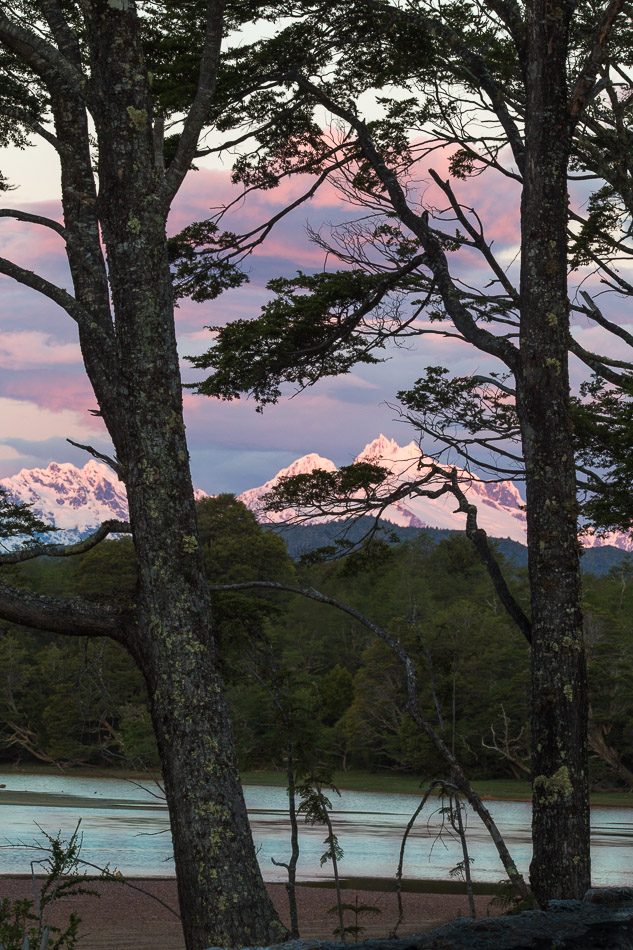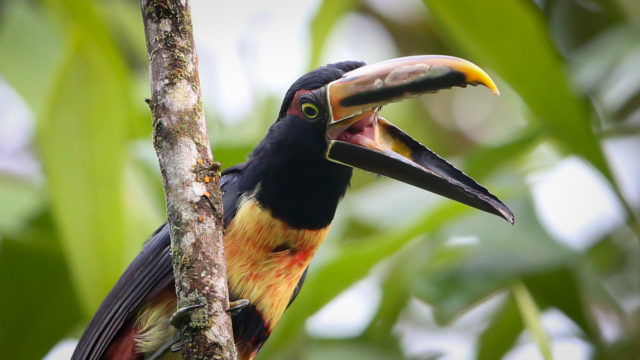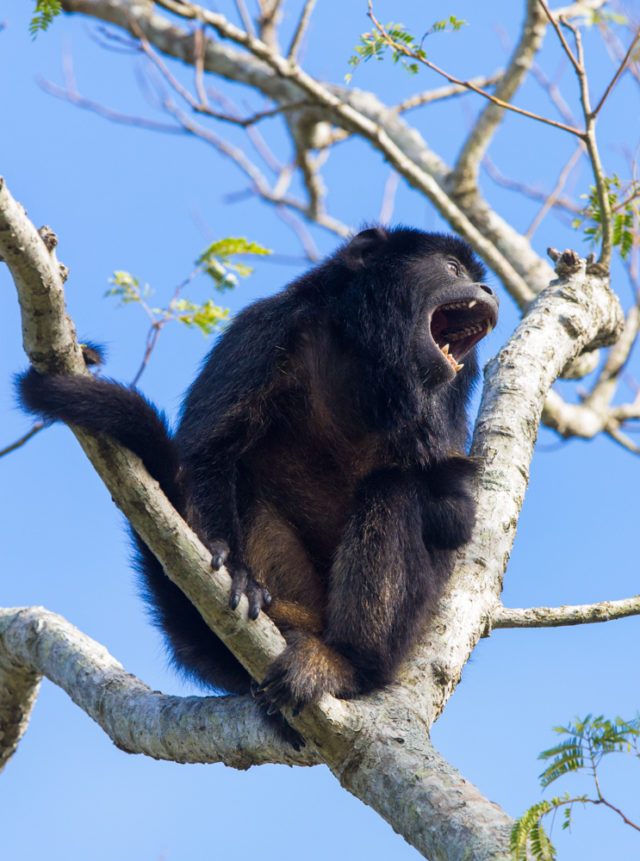Photo Blog
My name is Harry and I’m angry. Scientists and birders know me as a Collared Aracari but my friends call me Harry.
I live in the tropical forests of South America. My favourite place to nest is Colombia as the forests are big and quiet (or they used to be).
This is me with my angry face on.
Today some guys turned up in a big truck and started lopping down my trees.So off I flew to see a good mate of mine, Hattie, thinking, she’ll know what to do!
This is Hattie, she’s a Howler Monkey and when I told her what had happened, she howled (that’s what Howlers do best). Now she’s mad too, and when she’s upset you wanna watch it, look at those teeth.
Hattie had an idea, go and talk to the guys, reason with them, tell ’em to stop. After all it’s not their forest, they live in the city. We think that’ll sort the problem.
So that’s what we’re going to do tomorrow.
Hummingbirds are the Champion bird family on the high tops of the Andes. They are the High Hummers.
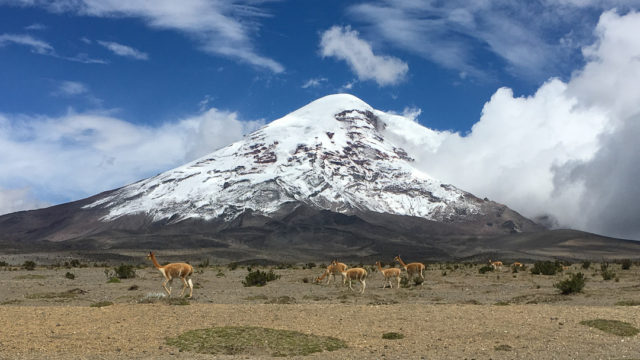
Smart adaptations enable them to survive at these oxygen depleted heights
During our overlanding travels in South America we have seen many of these High Hummers. This one is the Ecuadorian Hillstar found on the upper slopes of the Chimborazo Volcano. Despite being on the Equator, the upper slopes are dangerously cold. During icy wintery days this tiny bird has to crouch on the ground to shelter.
At night it will go into a state of ‘torpor’, slowing down its whole metabolism.
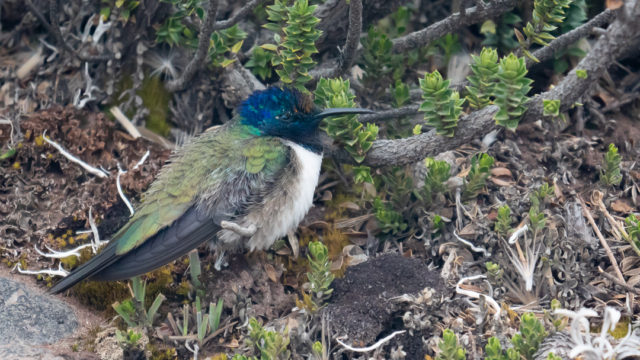
The Living Wild in South America team have produced a NEW VIDEO, High Hummers.
Go to our Video page to be amazed at what these tiny birds have to do in their daily battle to survive.
Every day brings a moral to living, today was knowing there were Three ways to earn a living.
You can stand around with your mates, waiting for something to turn up, such as these Snowy and
Great Egrets were doing.
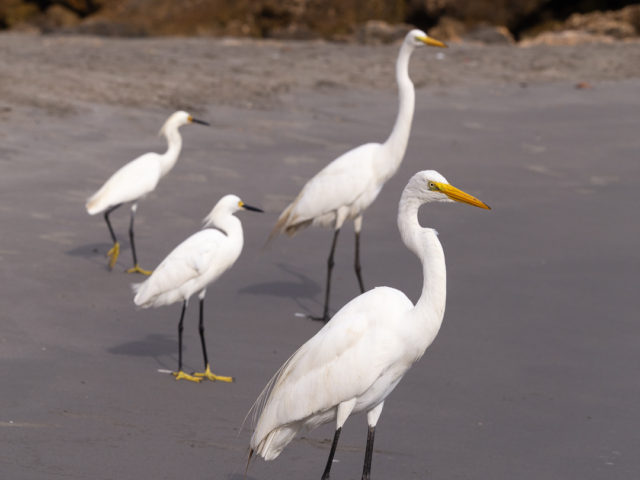
You can go work hard, like this Tricoloured Heron. Scouring the sea and rocks for a morsel to eat.
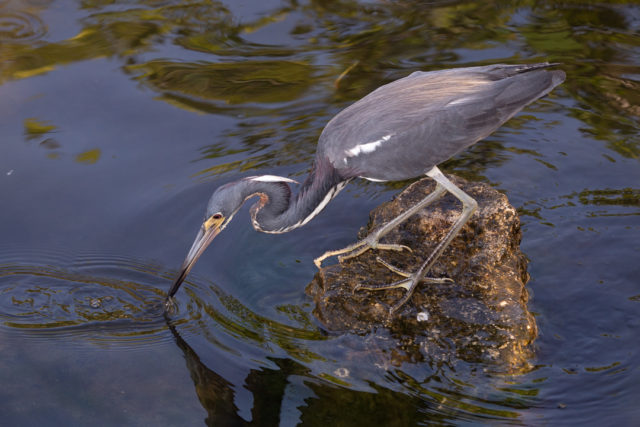
Or you can keep an eye open for an opportunity, maybe use a bit of cunning –
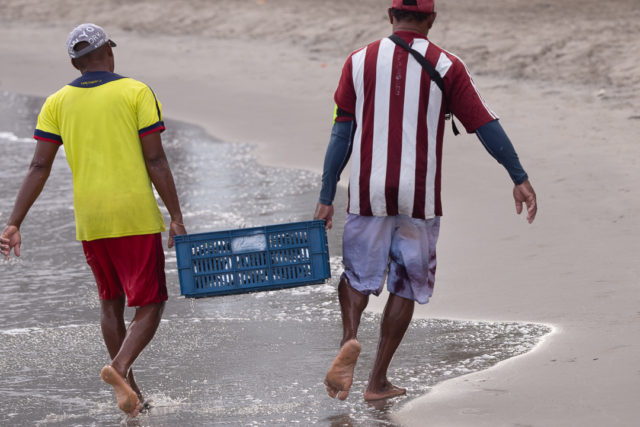
and get youself a free meal !
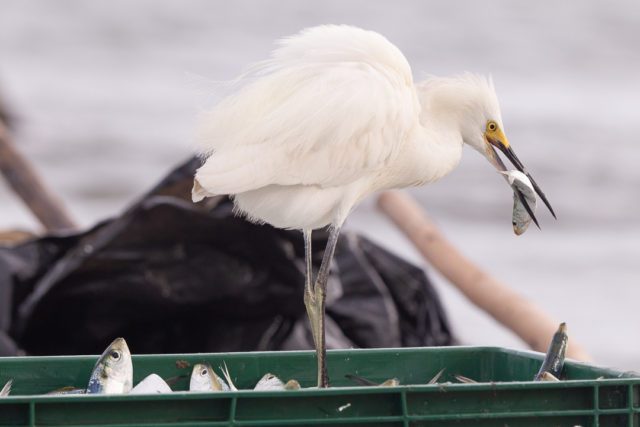
The bird with the white moustache is the Inca Tern, so named for its beautiful plumage, likened to the spectacular costumes of the Inca kings.
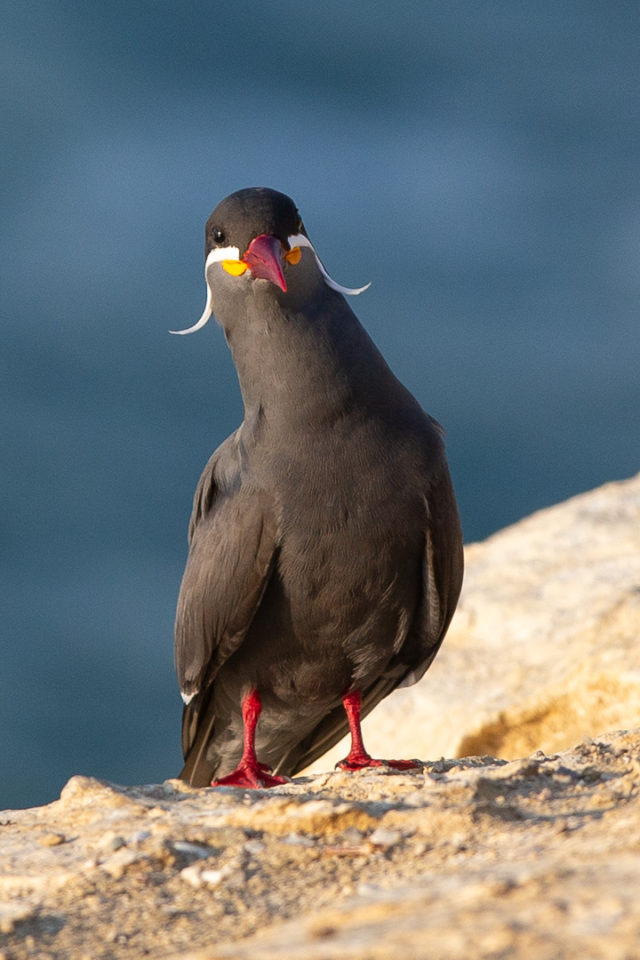
The birds are mainly to be found off the coast of Peru where the Humboldt Current comes close to the shore. This cold current brings a constant upwelling of nutrient rich water from the ocean floor which leads to a bonanza of fish, in particular anchovies, the favourite food of the Inca Tern.
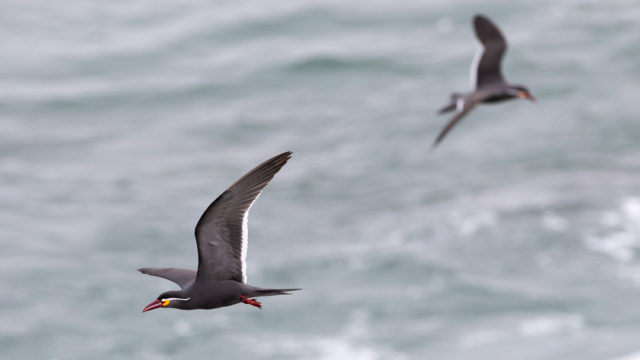
On previous visits to Peru we had seen distant Inca Terns a long way out over the sea, but never close and never on their breeding grounds. The place to guarantee finding the birds is Paracas National Reserve, near to Ica, south of Lima. Getting there meant taking the only road, along the coast where the vast yellow dunes of the Atacama desert reach down to the coast itself.
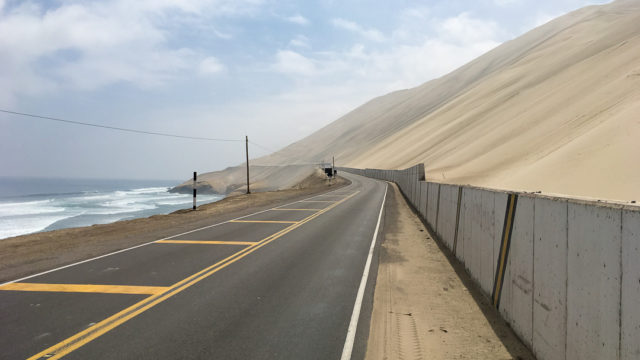
Paracas National Reserve protects both a large part of the ocean as well as the adjoining desert. Getting about, especially away from the few tourist centres is not easy. There are no facilities and a 4-wheel vehicle is essential. Neither of these are a problem to us and we were able to scout out various bays looking for potential cliffs where the Terns might nest.

We found a secluded bay, inhabited by just two fishermen living in a makeshift canvas awning, with whom we exchanged beer for freshly caught Mackeral. We stayed for three idyllic days, surrounded by the endless saffron mountains and lulled to sleep at night by the rythmic wash of the tide coming and going.
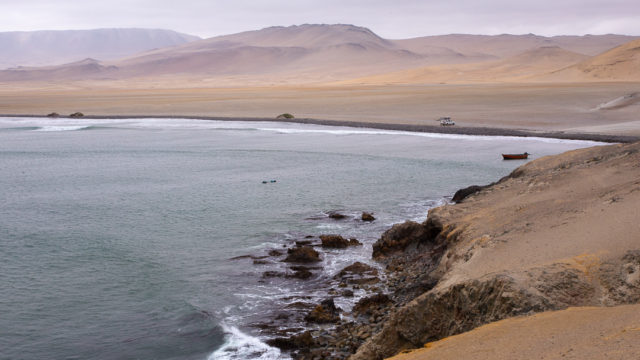
The days were pleasantly hot and every afternoon a strong wind blew off the sea.
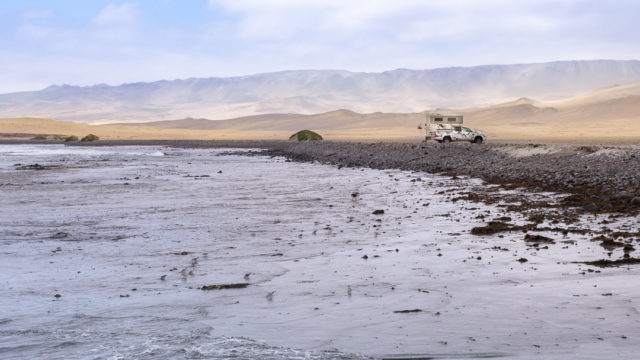
The pebbly seashore awash with strands of green seaweed attracting Sanderling, Surfbirds, Whimbrel and Golden Plover, all migrants from North America. Far off over the waves we could watch as the Inca Terns danced over the surface, occasionally darting into the blue to pick a fish.

Eventually we found a small section of cliff where Inca Terns were breeding. Access was dangerous due to the fragile and sloping edges of the cliff but we were able to watch the birds as they flew right by us.
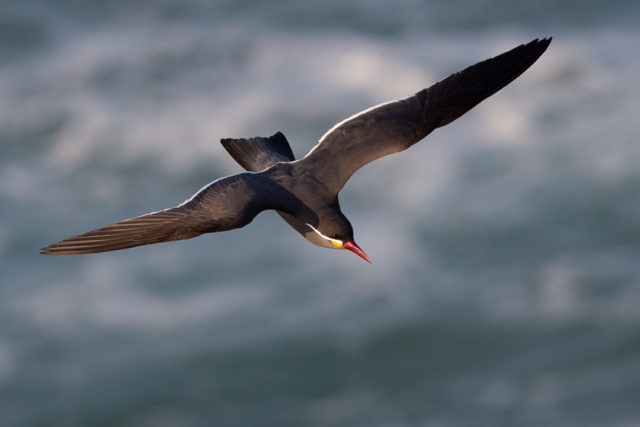
Evenings were the best time to watch for the birds as many more individuals returned to the cliffs from feeding out at sea. At that time, young birds would appear from their sheltered crevices and call to their parents. These calls would send the adults into a frenzy of activity, fluttering around the cliff tops, uttering a soft mewing sound.
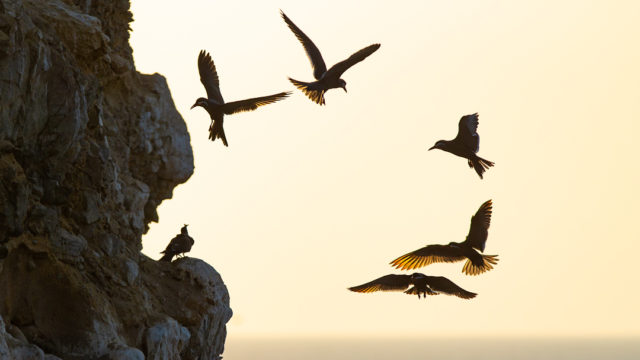
An alien circling high above our planet will see that the highest mountain on Earth is in Ecuador. The reason for this is that Mount Chimborazo stands on the widest part of the Earth, the equator.
When Alexander von Humboldt measured Chimborazo in 1801 he thought it was the highest mountain, so in true Humboldt style he tried to reach the summit. At 5,800m (19,000 ft) all his indian guides had deserted him and he himself had bleeding gums and was gasping for every small breath he could manage.
Humboldt is one of the greatest naturalists of all time and father of Biogeography. He was the first and greatest explorer of South America, a man whose writings encouraged Darwin to follow in his footsteps,
…. and, by the way, more places on earth have been named after this man than anyone else!
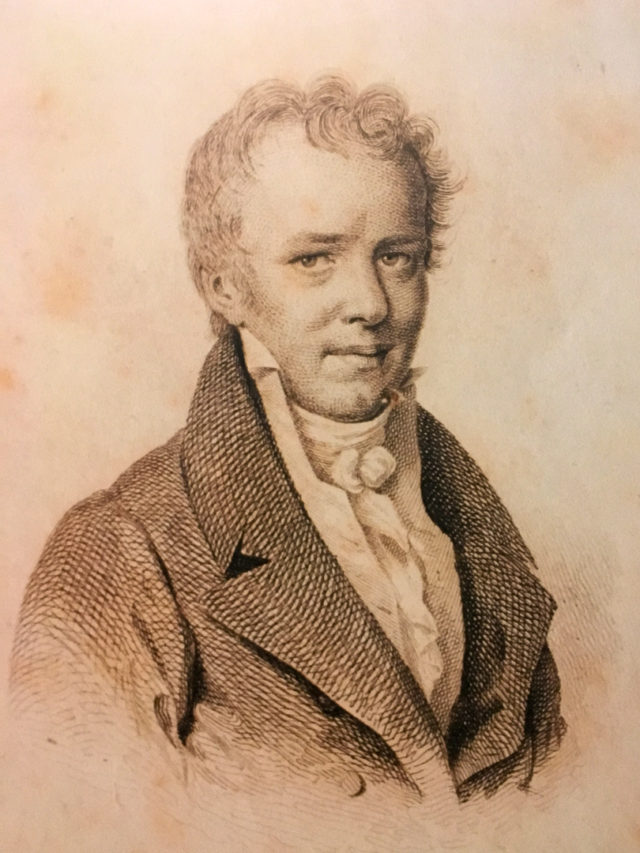
Our exploration of Chimborazo was far less exciting, hardly noticable in any way at all. But this mountain, or should I say Volcano, has left a lasting impact on us.
What drew us to Chimborazo in the first place was a hummingbird, the Chimborazo Hillstar, that lives on its volcanic slopes.
We crossed over the border from Peru and headed as directly as we could towards the volcano. With ever more sinking hearts, the twisting roads led us hour after hour through a highly agricultural mountain realm. Our imagination of what to expect in Ecuador had led us into a world of fantasy. We were expecting Ecuador to be wild and forested, it is not. This is a landscape that has been tamed by man for hundreds and hundreds of years. The majority of the forests have gone, the mountainous slopes turned into a tumbling of neatly kept tilled terraces. The growing of potatoes, maize, carrots and beans being the mainstay of the local economy.
Even in Ecuador, wildlife has to find hidden corners to survive.
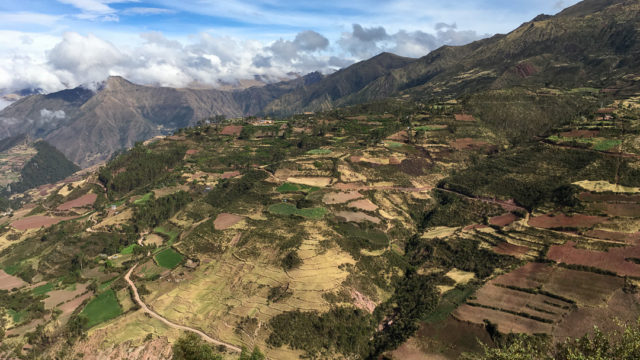
Driving up one set of hairpin bends we eventually straightened out onto a plateau and beyond, perhaps thirty miles away, stood a most beautiful sight, an ‘ice cream’ shaped dome of a mountain, Chimborazo.
Several hours later we arrived at the National Park road which led to the entrance gate. It was late afternoon so decided to park close by and drive further on the following morning. Our camp that night was at 4,150m (13,500ft). This is 3,000 ft higher than Hannibal had taken his troops over the Pyrenees, to smash the Roman army, a high altitude endeavour that cost the lives of 30,000 of his troops.
We had a shocking night, our sleep being fitful as the temperature inside our sleeping compartment dropped well below zero, we were even too cold to retreive the oxygen from our driving cab. For the second time in a day, our imagination of being on the equator, in Ecuador, the land of flowers and exotic fruits had played games with us. Chimborazo had caught us unawares.
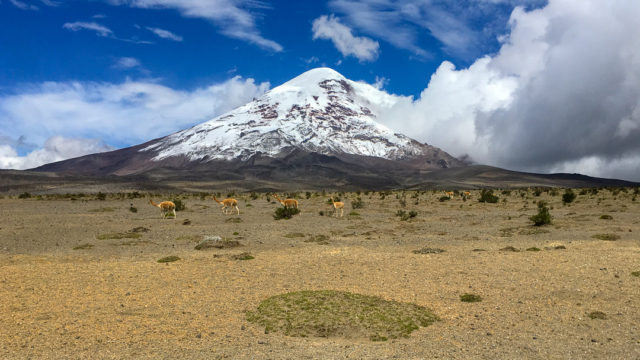
In the morning the ground outside glistened with frost. Our aim to be out before dawn being a ditched romantic dream. We huddled inside and ate hot porridge, retrieved the oxygen and went back to bed. When I did stagger outside, our first and, to date, our only Carunculated Caracara stood close by looking at me, a look of wonder on its face.
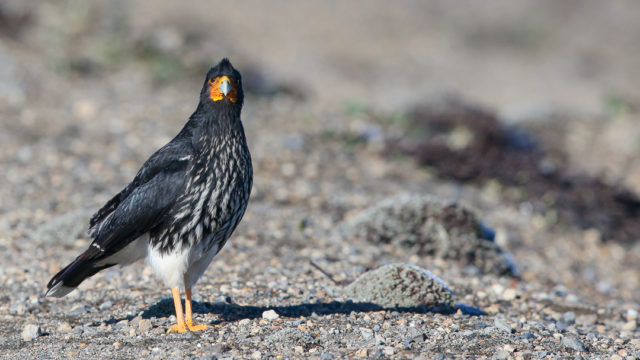
In the afternoon we were able to drive to the highest point vehicles can go, 4,900m (16,000ft). We had been at this altitude before in Chile but Chimborazo was much colder as a strong breeze blew from the mountain’s snowy summit and down its red rocky slopes.
Getting about with heavy camera equipment was a struggle and only very short walks were possible. The pebbly red and white ground crunched as we crossed a frozen moonscape of rock. Snowman high bushes with dark prickly leaves and orange flowers dotted the ground. We were aware of occasional ‘wraith’ like apparitions ‘zip.. zip..zipping’ over our heads. They were hummingbirds, but as they disappeared over the rocks and away, we never managed to see them properly and we hardly cared, we were done in !
We retreated to a warming car and soft seats and drove down to a local village some distance away, our admiration for Humboldt growing by the minute.
The following day dawned sunny and we managed to get to the highest parking area by mid-morning. The summit of the volcano was shrouded by swirling mist, making our hunt for the hummingbird even slower and more deliberate, breathing was difficult and every step felt as if we had bricks tied to our feet.
As on the previous evening, we saw hummingbirds occasionally fly high over our heads, but they disappeared over the moon-like scree slopes.
The reason why this Hillstar is here at all in such an inhospitable environment is due to one plant, the orange flowering shrub Chuquiraga jussieui, one of the national flowers of the Andes, a native to the highlands of Colombia, Ecuador and Peru. It is the flowers of this shrub that provide the nectar, for the enigmatic Hillstar Hummingbird. The bird though, does a much more important task for the plant, transporting its gene laden pollen from one shrub to another. The plants are not common being widely scattered across the landscape so to chance pollination to the wind is too risky a strategy, enticing a efficient servant to do the job for it is much safer.
We decided the best way for us to see a Hillstar close too was to watch some of the Chuquiraga bushes.
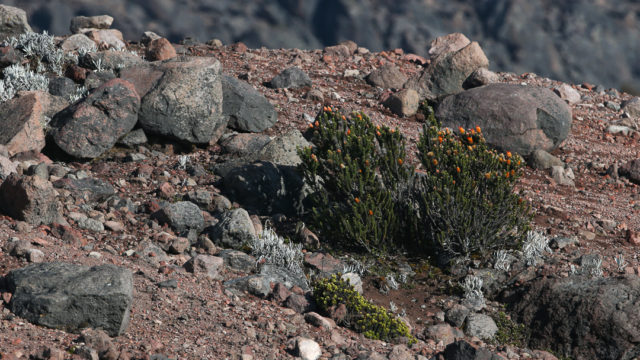
Suddenly one shot into the air from over a ridge but again disappeared. Puzzled, we continued our vigil, hands and cheeks becoming more numb by the minute. The bird re-appeared and settled down again in view on the ground in the lee of a bush. The reason we had been unable to find the birds was because they were going onto the ground, seeking shelter.
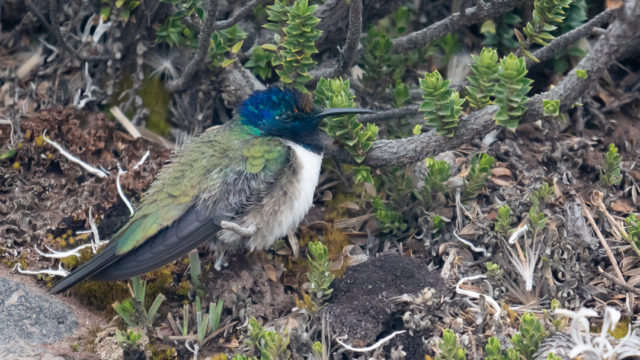
Another bird appeared and darted behind a rock, I slowly edged forward and peeked behind and it immediately flew off. Putting my cold hand where the bird had been sitting, I felt a slight warmth radiating from the rock, heated by the sun during the morning.
Like us, the birds were desperate to keep warm, this was their and our limit of endurance.
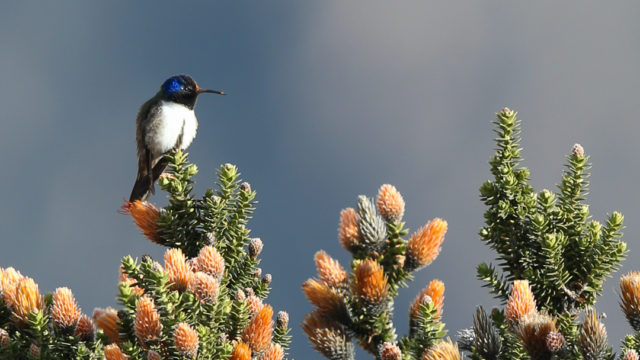
Colour, energy, succulent food and sultry heat, these are all the ingredients for a love affair in the tropics.
The two partners are passionate about one another. They need one another, they cannot live without each other and each are dressed in costumes that sparkle – like all great celebrities do.
These celebrities are firstly, the energetic, dazzling hummingbirds of the New World, who move about the tropical forest like high speed racers.
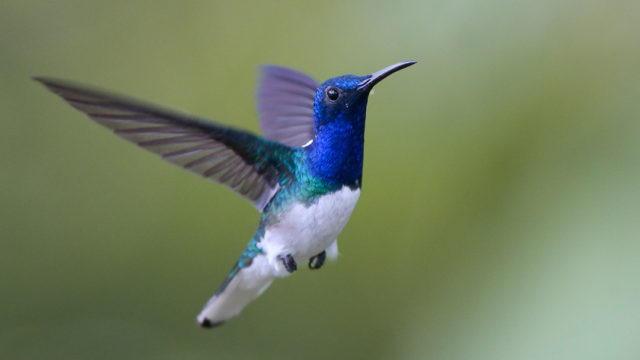
Secondly there are the architecturally shaped, exotic, Heliconia plants. They hide away amid the dark green foliage, but are clothed in an orange or red mantle that would outshine a queen.

The hummingbirds seach for the plants and the heliconias wait for the birds.
When we walk through tropical forests there is often a sense of foreboding. The darkness and damp humidity surround us as we stumble over storm thrown trees. Occasionally amidst the dim verdant luxuriance we can see splashes of bright enticing colours.
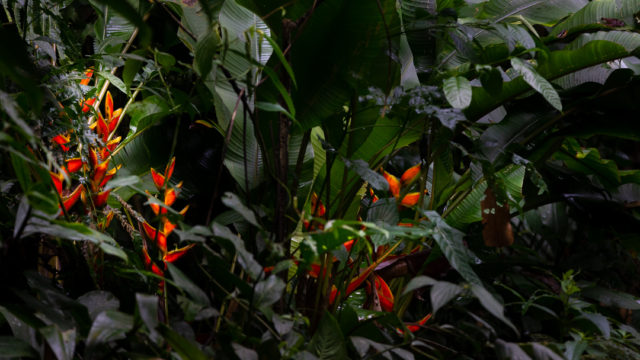
These are the Heliconias and they brighten up the forest as nothing else quite does. In fact Heliconias are so named after the greek Mount Helicon, the home of the muses. The muses were the goddesses of literature, science, art and music, all the aspects of life that are bright and beautiful, most worthy and sought after.
Heliconias and Hummingbirds are partners that evolution has crafted for millions of years. Heliconia plants have designed their weird and wonderful shapes to attract different species of Hummingbirds.
A Green Hermit Hummingbird, its wings beating at 50 beats a second, holds itself steady whilst it bends its head sideways and manoeuvres its bill into a tiny tubular flower.
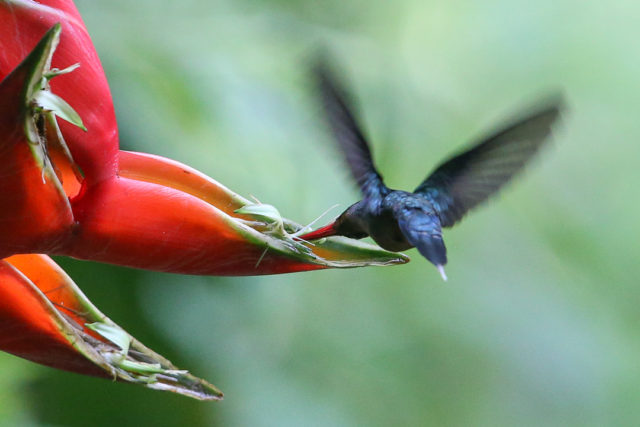
Deep within their colourful outer shells, the plants hide tiny insignificant flowers rich in nectar. Hummingbirds have tongues twice as long as their bills and it is this as well as their ability to hover in flight which enables them to extract the nectar.
A Violet-tailed Sylph extracting nectar to nourish its high speed lifestyle.
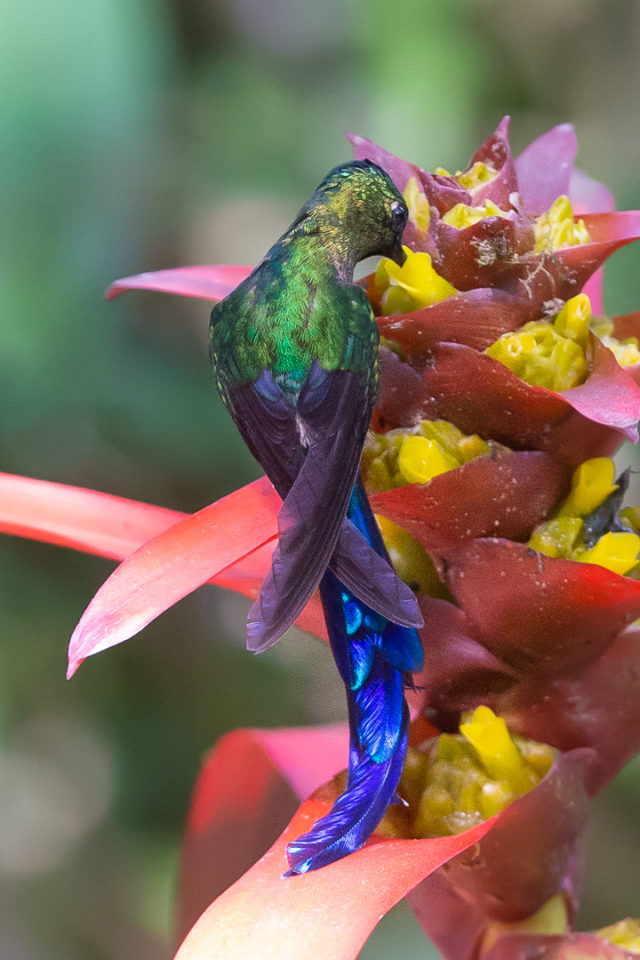
In so doing the flowers deposit pollen on the bird’s head and when the bird visits the next flower, pollination is complete. A love affair in the tropics that benefits the whole forest.
At the coldest time of the year the wonder of wintering geese cheers us up and we know the seasons have changed when we hear their airborne cries and yelps. January and February in northern Europe is deepest winter, the earth held in an icy grip. A tough time for most birds – but not geese. The Netherlands are the winter sanctuary for hundreds of thousands of geese from Russia and the far North, like these Barnacle Geese.
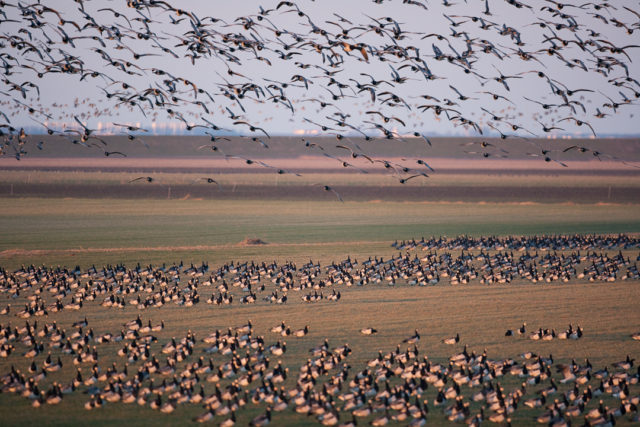
In Arizona, New Mexico and southern California the wonder of wintering geese comes in the form of Snow Geese, which arrive by the million, pushed by the harsh winter in their summer breeding home of arctic Canada.
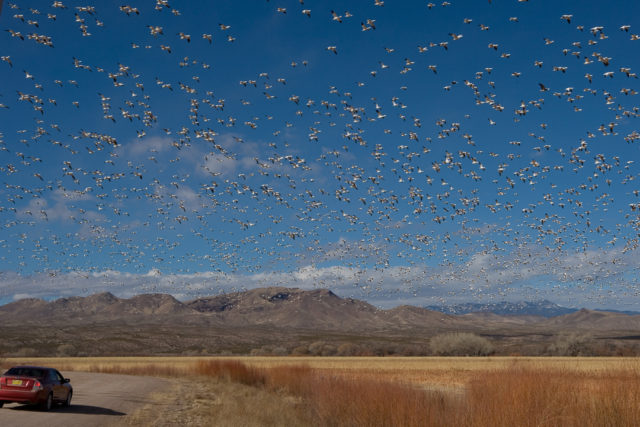
Argentina’s mid- winter is July and a beautiful goose, that breeds in the high Andes, then descends to lower elevations. This is the Andean Goose and we were fortunate to see many of these birds in NW Argentina near to Tafi del Valle in the province of Tucuman.
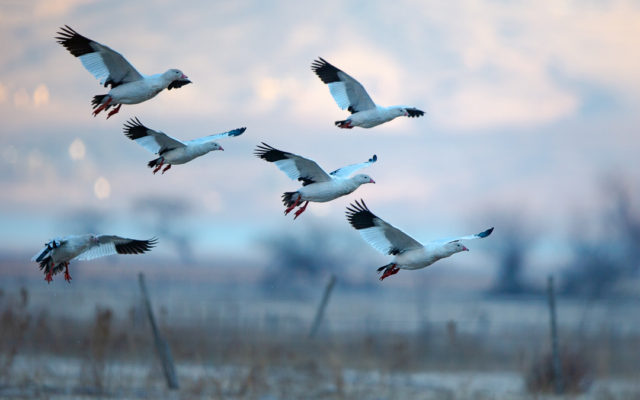
Paula and I would be out well before the orange glow of dawn streaked across the marsh. Settling down at our favourite spot close to a fence we would wait. Eventually their high pitched calls would alert us as the geese drfrited low over the willow trees and came down onto the frosted grass.
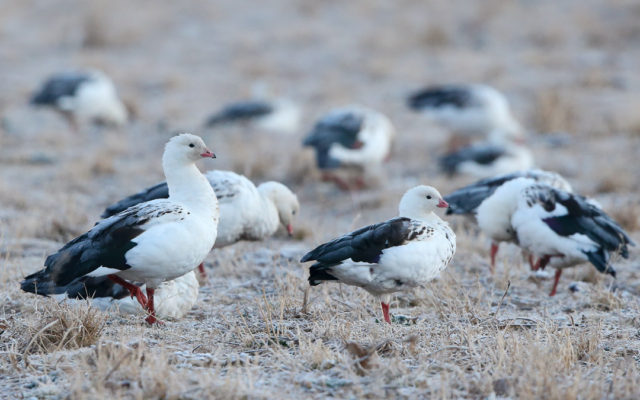
Having lived Wild in South America for some years we can honestly say that not all tyrants are in Venezuela.
We love Venezuela but there are more Tyrants outside the country than in it. I’m talking about birds of course, the family of Tyrant Flycatchers.
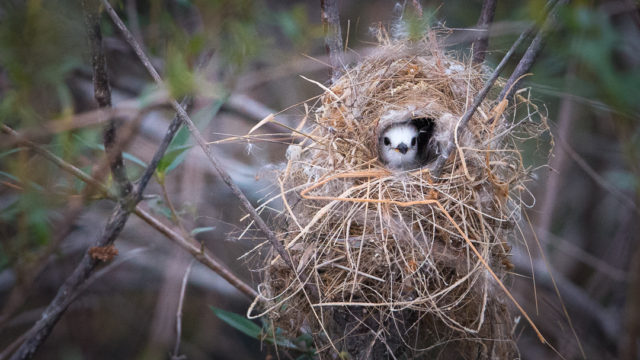
Tyrant Flycatchers are the largest family of birds in the World, living throughout the Americas from Canada down to Patagonia.
Tyrants are unscrupulous, agressive, domineering and vicious and many of these traits apply to the feathered family of Tyrant Flycatchers. The birds are highly territorial and we have seen them defend nest sites against much larger birds, other Tyrant Flycatcher species or even hawks. We saw this pair of White-headed Marsh Tyrants defend their beautiful domed nest against Strange-tailed Marsh Tyrants.

All Tyrant Flycatchers have relatively broad, flattish beaks which have a small hook at the end. This indicates that their preferred food is other animals. Insects provide much of their food but many of the larger species will take small amphibians and reptiles as well as small rodents.
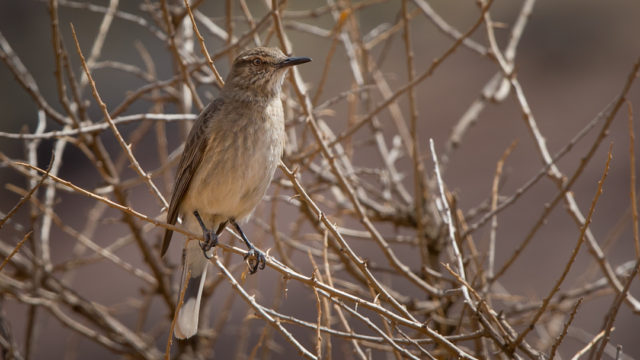
From a birdwatcher’s or bird photographer’s point of view they are not the most exciting of bird families. However the success of the family, there are 400 species, makes them an unmissable element of new world ornithology.
Only two thirds of all the Tyrant Flycatchers are actually flycatchers.
They are to be found in practically all habitats -from the lowland tropical forests of Peru
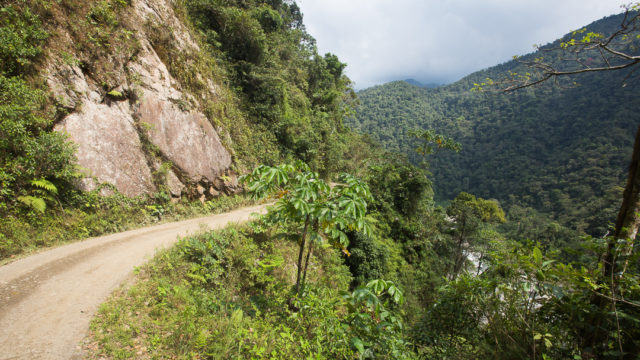
To the high altitudinal volcanic mountains of Chile.
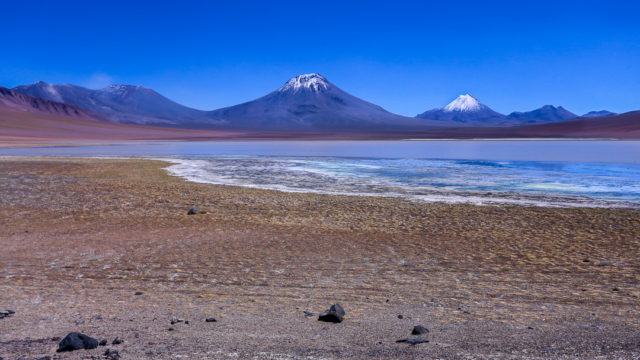
Everywhere in the Americas is home to one tyrant or another. Our time travelling over the wildlands of Patagonia was interspersed with views of the Chocolate-vented Tyrant. During the breeding season the birds would call into the fierce Patagonian winds, siren voices in the wilderness. These are the tyrants that bring pleasure to our lives.
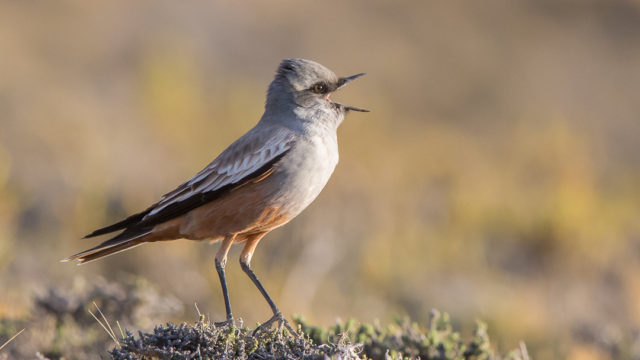
The northern coast of Chile is rocky and desolate, but one day we came across a very special rock.
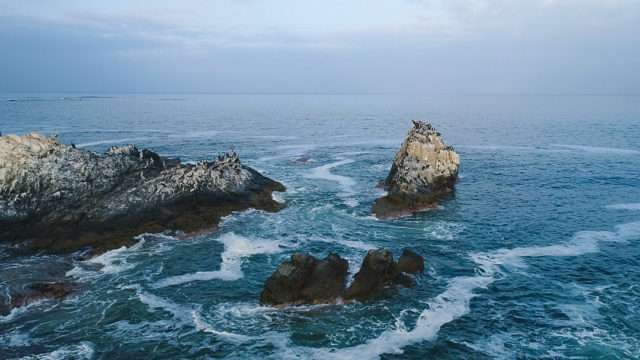
Special because it was both inaccessible and yet close enough to the shore to easily see the wildlife that lived on it.
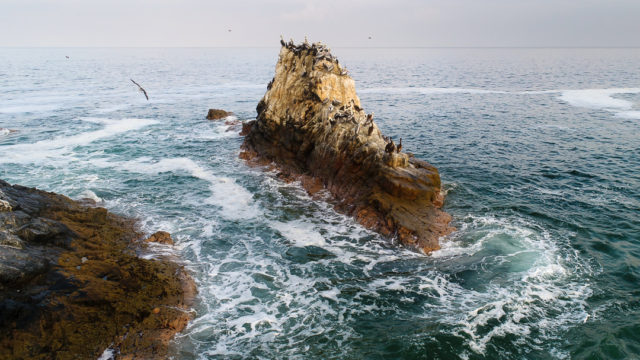
We camped on the beach for three days and saw just two fishermen in that time. The only sound was that of the sea and birds.
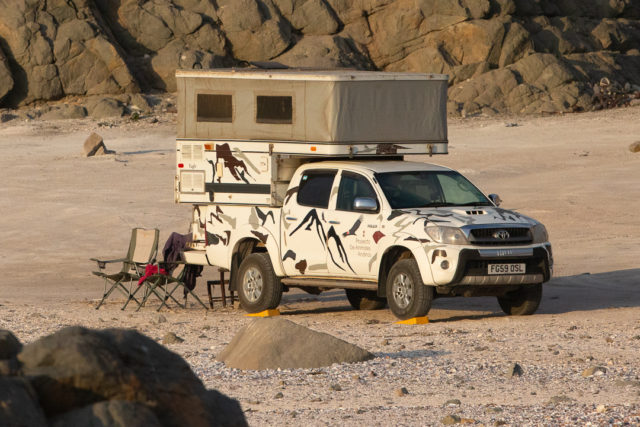
Red-legged and Guanay Cormorants nested on the rock. Whilst Peruvian Pelicans and many other birds used it as a safe place to rest.

By carefully walking across the slippery rocks I was able to get close enough to watch and film the birds without disturbing them.

An opportunity to get some great shots

There is nothing new about aerial photography. What’s new is that now anyone can now do it.
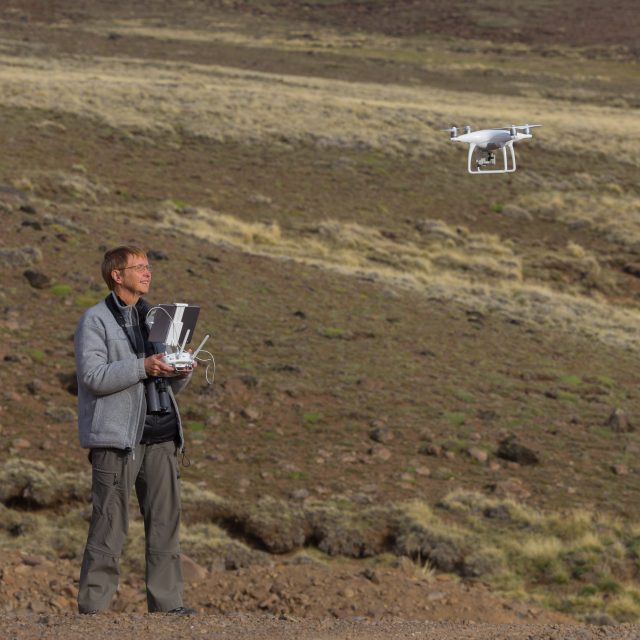
We have a drone with us in South America, which we use for landscape and habitat photography.
We have found that with a Phantom 4 drone its a great advantage to use our iPad as the monitoring screen. Its size and high resolution enables us to follow the drone easier.
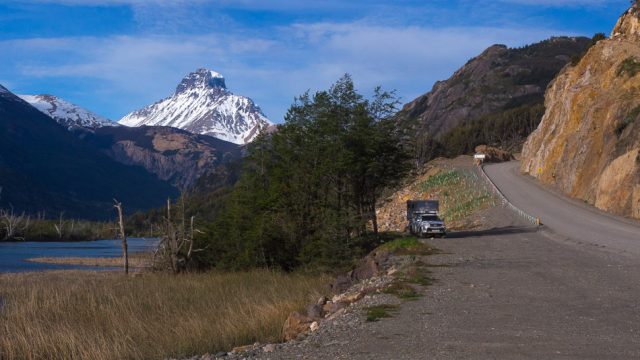
We were camping for a night in a wonderful location in southern Chile, surrounded by blue lakes and snow clad mountains.
We knew that in front of us was a magnificent landscape, but how were we to photograph it.
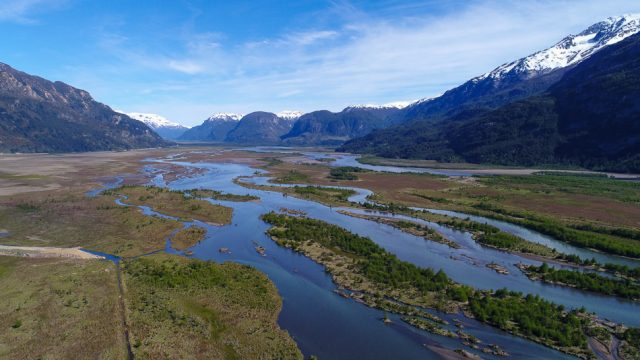
Launching the drone directly above our van, we were able to get this image of the valley, a landscape we only imagined existed.
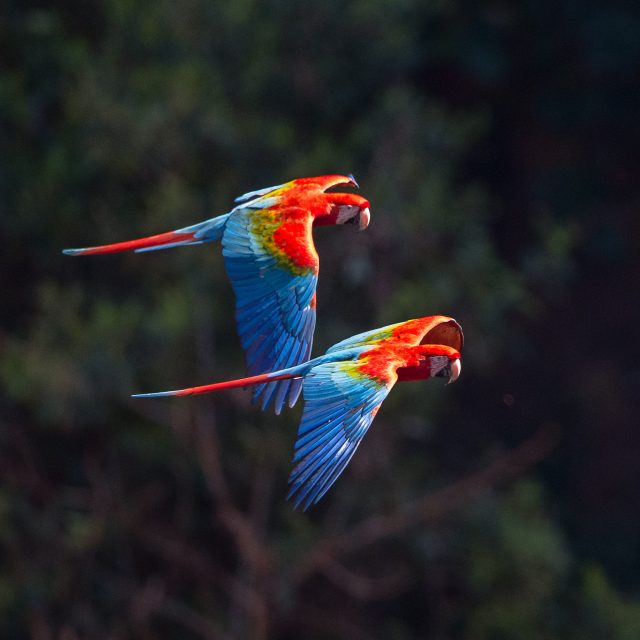
The Red and Green macaw feeds off the fruit of the Boukavia Palm. But a biologist may want to get much better pictures of the actual fruit.
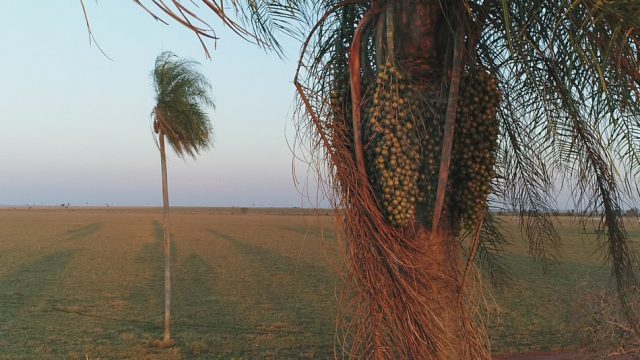
Using the drone enabled us to get close up to the fruit.
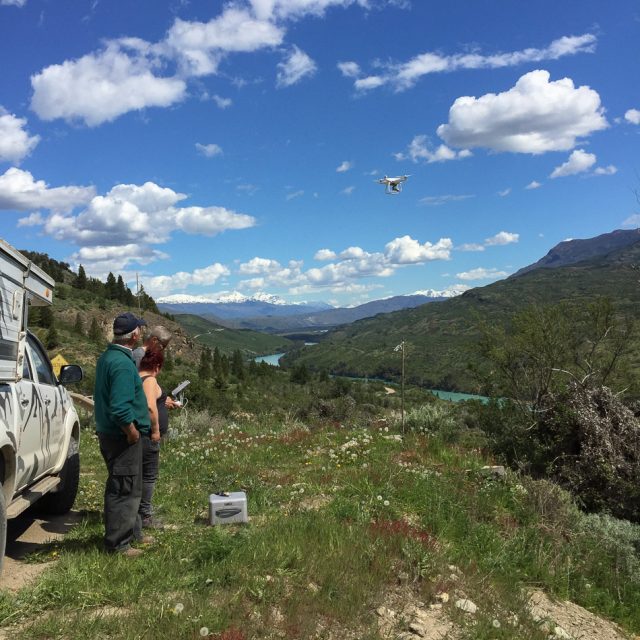
The Baker river and valley is one of the most pristine landscapes in southern Chile. The glacial fed river being a luscious emerald colour.
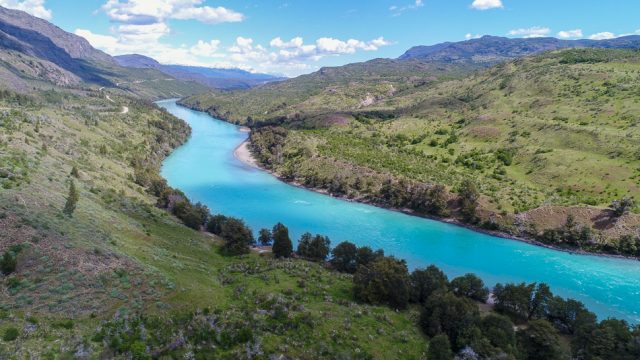
So we launched the DJI Phantom 4 drone.
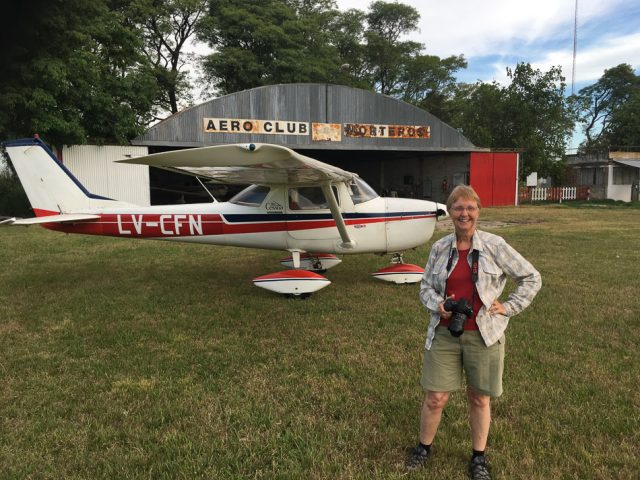
There are many occasions when a drone is not sufficient. Only a plane will do, but beware.
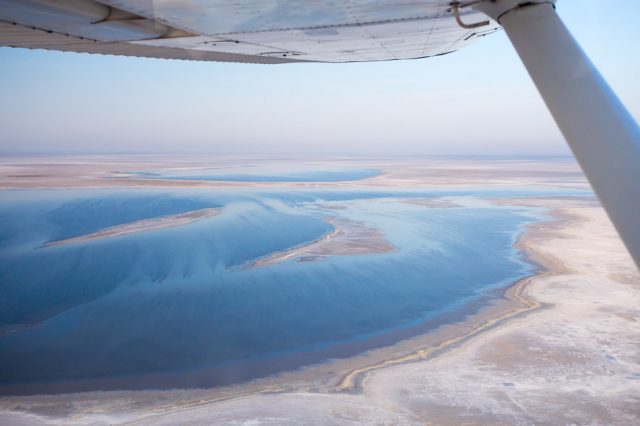
Aerial Photography from a plane is not easy. Choose the plane carefully. There will be little room, the weather may cause a small plane to shake about. Wing struts may get in the way.
But a plane is the only way to get high and get the shots you really want.
The Red and Green Macaw is a wow of a bird.
Paula and I have seen them and wow they are awesome.
We have watched the birds fly in formation. Red streaks through the lush foliage.
Their penetrating shrieking calls driving through our heads
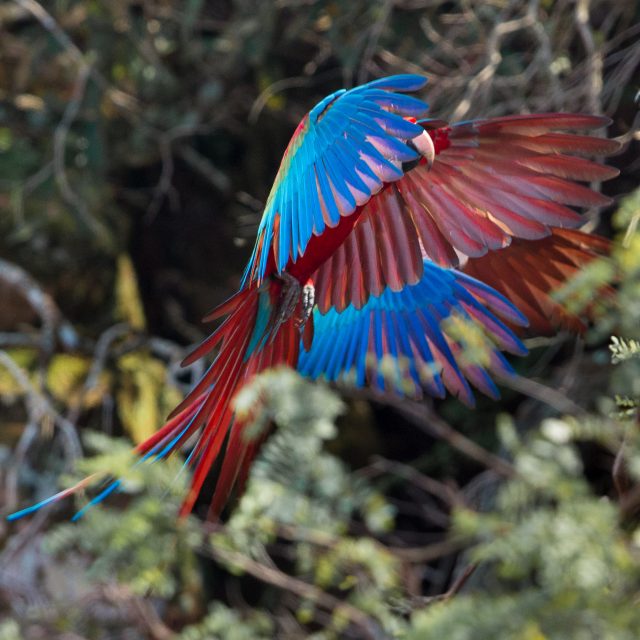
Now I believe the word ‘wow’ is much overdone.
I recently bought a friend a chocolate and strawberry milkshake and the reply was ” wow thanks”.
That made me think more about the word ‘wow’.
Should I apply it equally to a Red and Green Macaw as well as a strawberry milkshake?
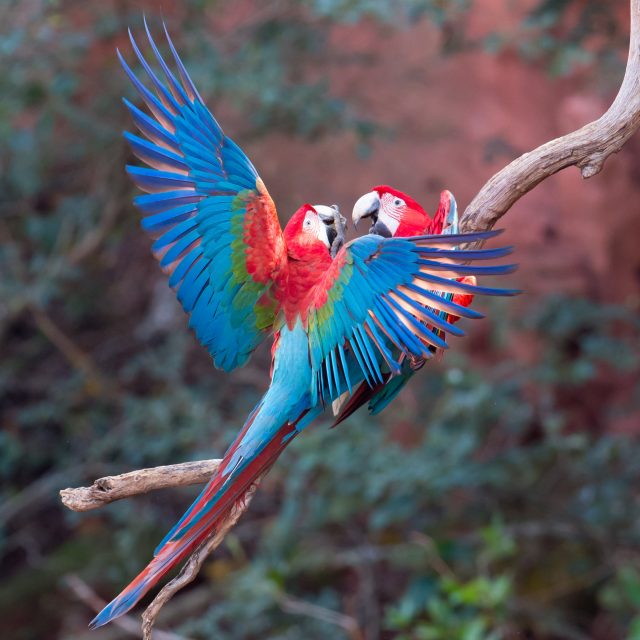
Now the word ‘awesome’ is even more overdone than ‘wow’ and we have heard people call a drink at the bar ‘awesome’.

One of the things I miss most as we are Living Wild in South America is a good English beer.
But I wouldn’t attribute a beer as ‘awesome’.
A beer is a beer. Everards Tiger is tasty, full of hops, smooth and delicious, that enough.
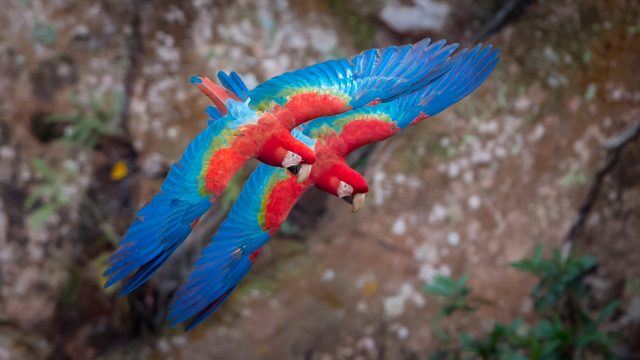
We were in the forests of Brazil some months ago and were watching Red and Green Macaws.
The birds mate for life and we often saw the pairs flying together in close formation. A lovely sight.

Our sightings of Red and Green Macaws might just be ‘awesome’, it is a wow of a bird.
But the most awesome day possible would be to eat a strawberry milkshake for breakfast.
Spend the day watching Red and Green Macaws and finish with a drink of Everards Tiger.
Long distance biking is common in South America. There are a number of reasons for this.
Long Distance Biking
- Biking the length of South America takes people from the shores of the Caribbean, to seas overlooking the Antarctic.
- The biking trails from Tierra del Fuego to Colombia are beautiful and picturesque.
- All the countries you pass through speak the same language – Spanish.
- The Ruta 40 in Argentina and the Carretera Austral in Chile run either side of the Andes
- Even more challenging is an extension by venturing on to Alaska, then you can bike the whole Americas. From the top to the bottom of the world.
Our travels as the Living Wild in South America team has crossed paths many times with bikers.
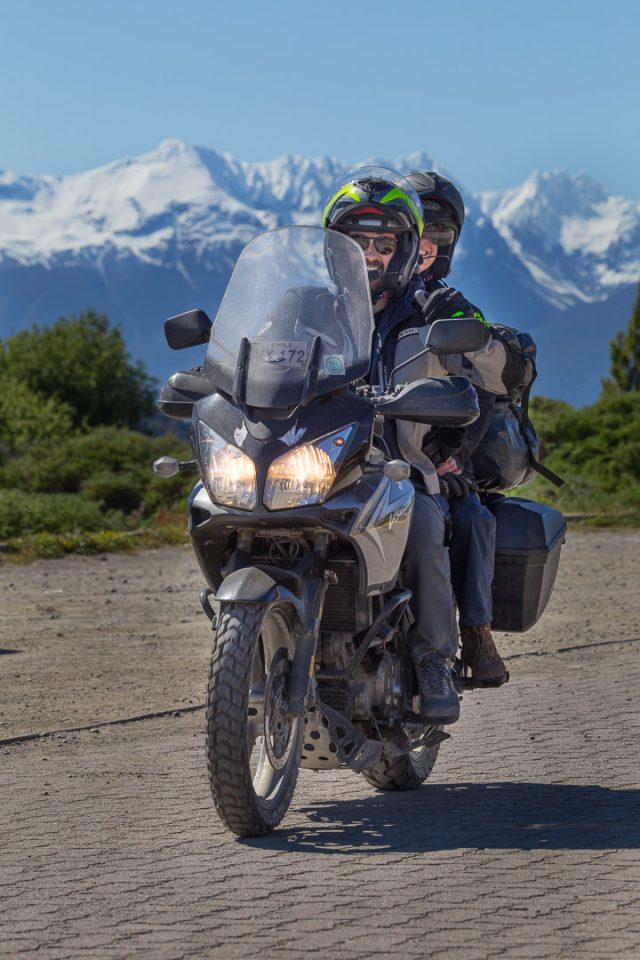
We regularly stop for a chat, finding out where they’ve come from or going to.

This is Rich and Emma from the UK.
They left their jobs behind and took off to bike from one end of South America to the other.
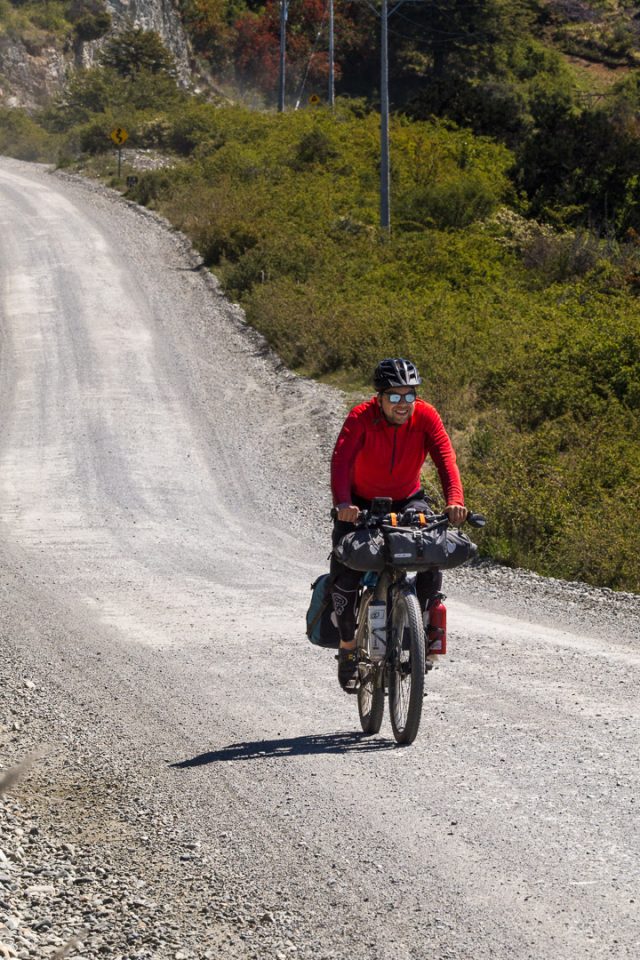
Share a coffee and biscuit at the side of the road, as we did with Dario from Germany.

Admire some amazing bike gear and be completely surprised when we met up with this couple from Brazil.
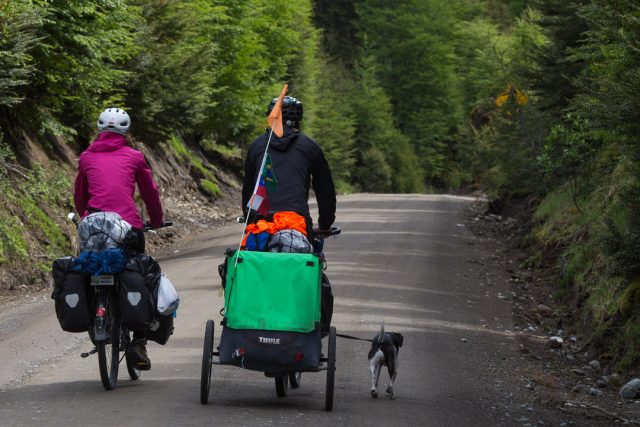
T
hey took their dog along and when the mut was tired, into a tiny 3-wheel carriage it went for a rest.
That was not just long distance biking, more like long distance dog walking.
The outrageous way I think of Chile is to imagine the parrots that live there.
When I think of Parrots I try not to imagine palm trees and jungles.
Having visited Chile I now think of Chile as not typically shaped, its a bizarre shape.
Chile is crazy, its 4700 km long but only 170 km wide. I have found Chilean landscapes to be mountainous, and glaciated or dry and desertified.
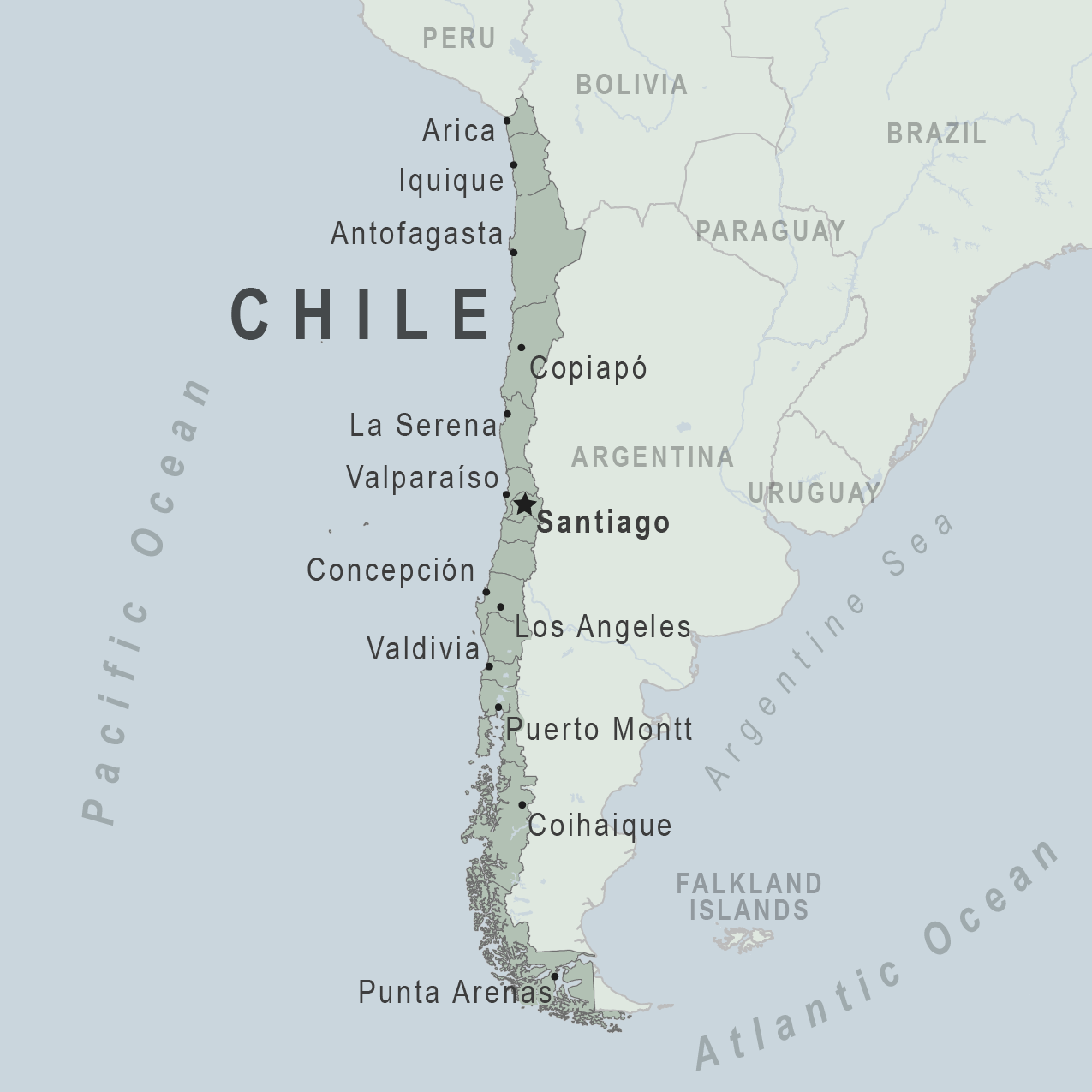
The outrageous way I think of Chile is now to imagine the parrots that live their, and after our travels I have seen all of them.
Chile has 5 parrots.
1 Burrowing Parrot – Cyanoliseus patagonus
2 Austral Parakeet – Enicognathus ferrugineus
3 Slender-billed Parakeet – Enicognathus leptorhynchus
4 Monk Parakeet – Myiopsitta monachus
5 Mountain Parakeet – Psilopsiagon aurifrons
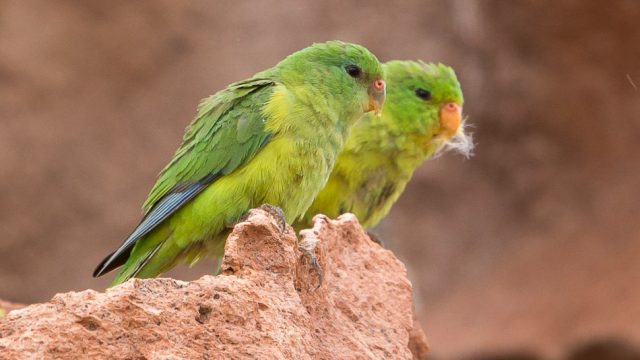
High up in the Andean mountains where it is hot and dry there lives the Mountain parakeet. Unlike most Parakeets this one feeds mostly on the ground.
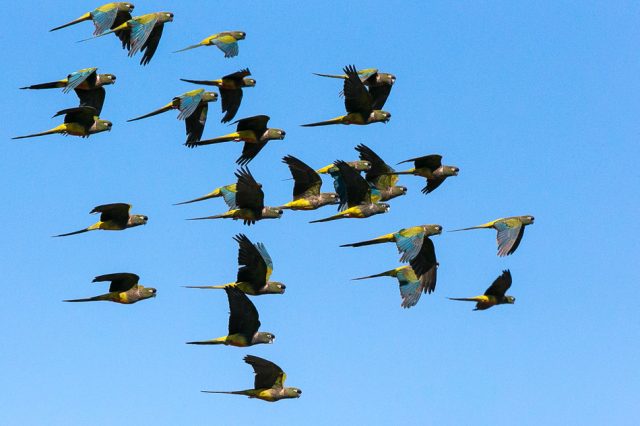
Burrowing parrots are now endangered. There are less than twenty nesting colonies left in the country. A bizarre parrot which does not favour trees but nests in holes in cliffs.
T
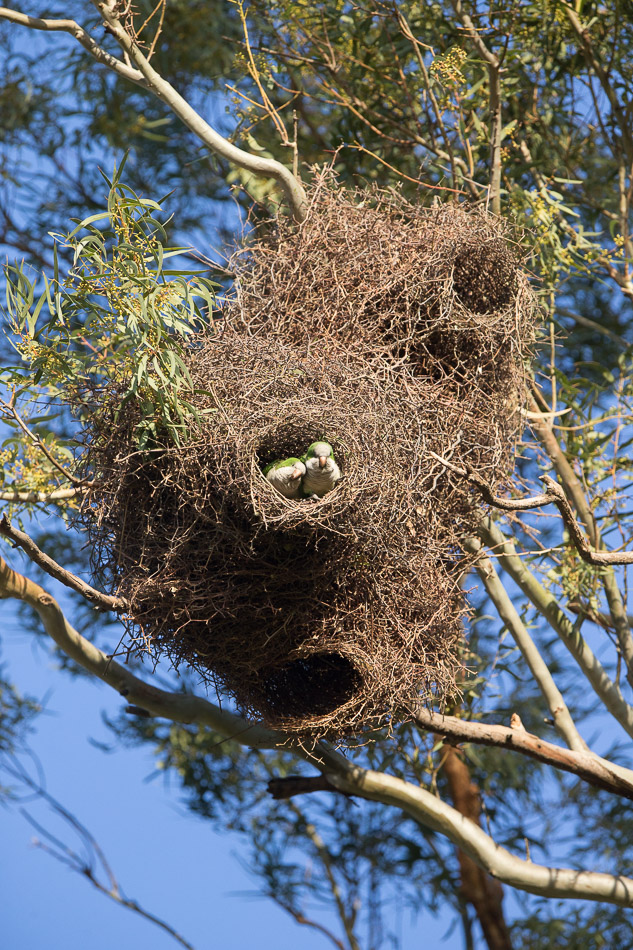
he Monk Parakeet is common and is just as likely to be found in towns and cities. It builds huge nests in which a number of Monk Parakeet families live.
Many of these nests are on top of pylons which can cause significant problems due their heavy weight.
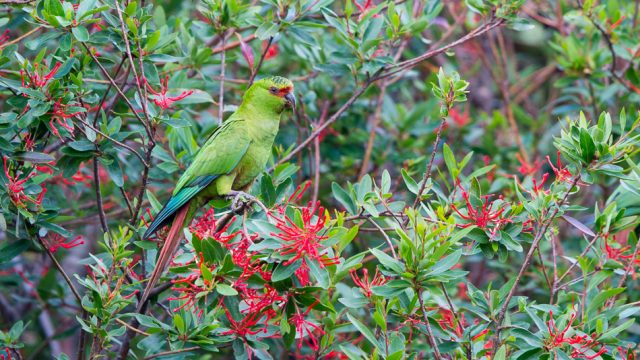
The Slender-billed Parakeet is another endangered parrot of Chile, more importantly it is endemic to the country.
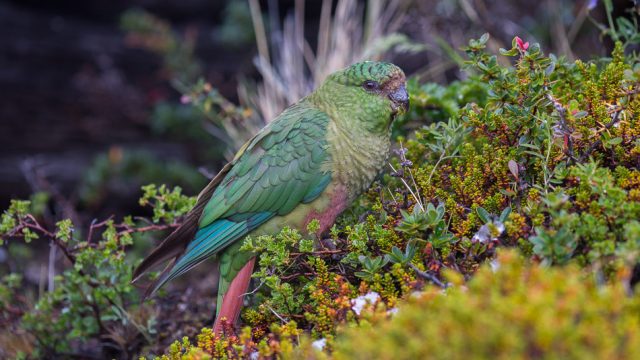
The Austral Parakeet is perhaps the most bizarre. These parrots only live in the deep south of the country, a land of snow and glaciers.
An outrageous way to think of Chile therefore is to think of these five parrots and their crazy lifestyles. there.
If there was an Olympic competition for the most beautiful country in the world, Chile would certainly be on the podium and the crowd would be shouting – “Chile for Olympic Gold”
On Sara Wheeler’s travels through Chile a drunk told her this legend about his country.
“When God created the world he had a handful of everything left – deserts, mountains, lakes, glaciers – and he put it all in his pocket
But there was a hole in this pocket, and as God walked across heaven it all trickled out, and the trail it made on earth was Chile”
That drunk must have known a lot about Chile. For Chile is a ridiculously beautiful country, so diverse, accessible and dramatic. It really is – “Chile for Olympic Gold”.
Ridiculous because the spaghetti sized Chile stretches from the sub-tropics to Antarctica – but is only as wide as the English Channel.
A beautiful country, because its western side is brushed by the Pacific ocean and its east by the greatest mountain chain on earth. Its landscapes are nearly perfect.
Landscapes of Chile
1 Deserts
In the north is the stark and stunning Atacama desert. The driest place on earth with pink mountains and hidden oasis.
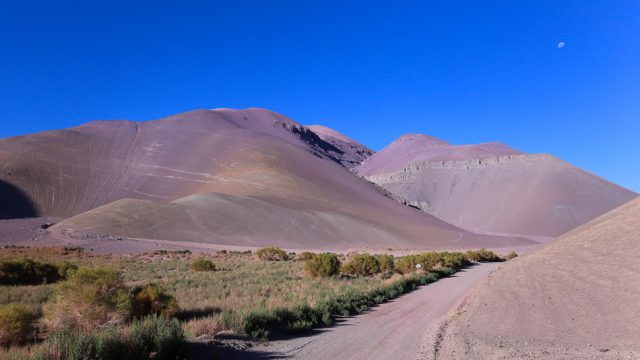
2 Flowers
The central part of the country makes you feel as if you are in the ‘Mediterranean’. The flora are an endemic hotspot of biodiversity. Valleys of colour, exotic and perfumed air.
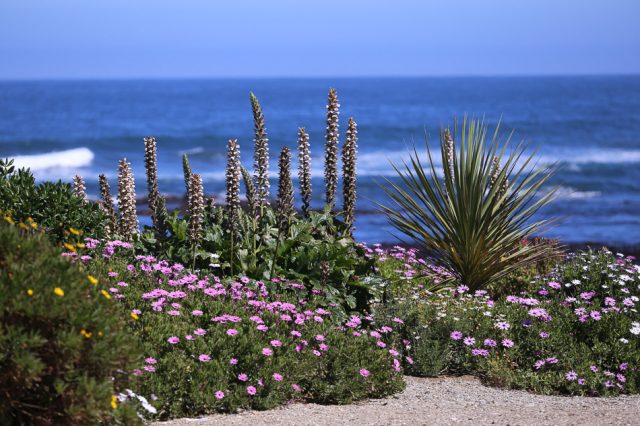
3 Mountains & Lakes
Further south are the most gorgeous lakes and snow clad mountains. A photographers dream, surreal and silent.
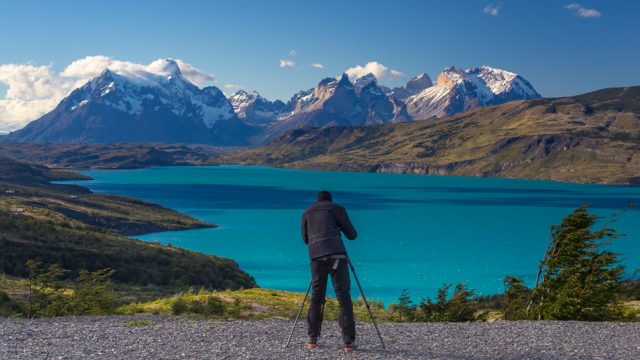
Glaciers
Further south still, within a short sea journey to Antactica, you will find glaciers, cold winds and short days.
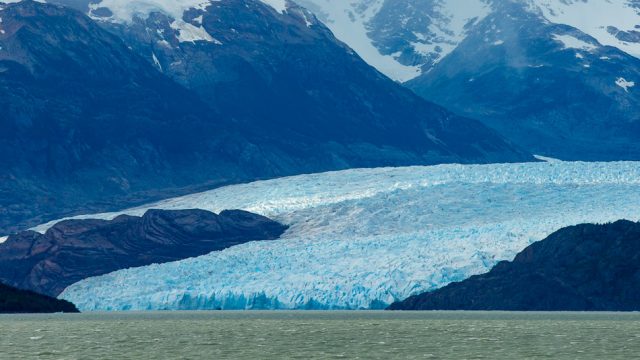
It takes a great imagination to consider your country as being the remains of bits and pieces lying in the bottom of Gods pocket.
“When God created the world he had a handful of everything left – deserts, mountains, lakes, glaciers – and he put it all in his pocket
But there was a hole in this pocket, and as God walked across heaven it all trickled out, and the trail it made on earth was Chile”
Perhaps he was just ‘drunk’ on the beauty of his country.
” Whats so special about the Valdivian Temperate Rain forest” ?
That was the questions we asked lots of people – and to our surprise, no one had heard of it.
That’s what’s so special about the Valdivian rain forest, its unknown.
Amazing facts about the Valdivian Forest
- Its the third biggest in the world, after the Amazon and the central African rain forests.
- Its a Temperate rain forest
- Its the only rain forest with Glaciers
- 60% of its plants are endemic
The location of the Valdivian rain forest.

The word ‘rain-forest’ tells you that this is bound to be a wet area, a very wet area.
Many times whilst we were photographing the trees we had so much rain running down our clothes, our boots filled up.
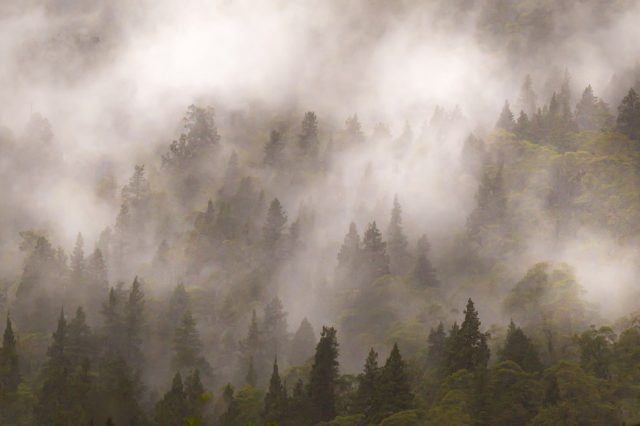
The source of this rain is the westerly winds off the Pacific.
Reaching the coast with the Andes immediately behind, the clouds burst.
Many coastal areas, including Chiloe island, receive up to 4 meters a year.
Such a special, extreme climate, is likely to produce a special animals and birds
Accordingly the Valdivian forest has evolved plants and animals as special as anywhere in the world.

Enormous ferns taller than a man, help to make this,one of most spectacular woods we’ve been in.
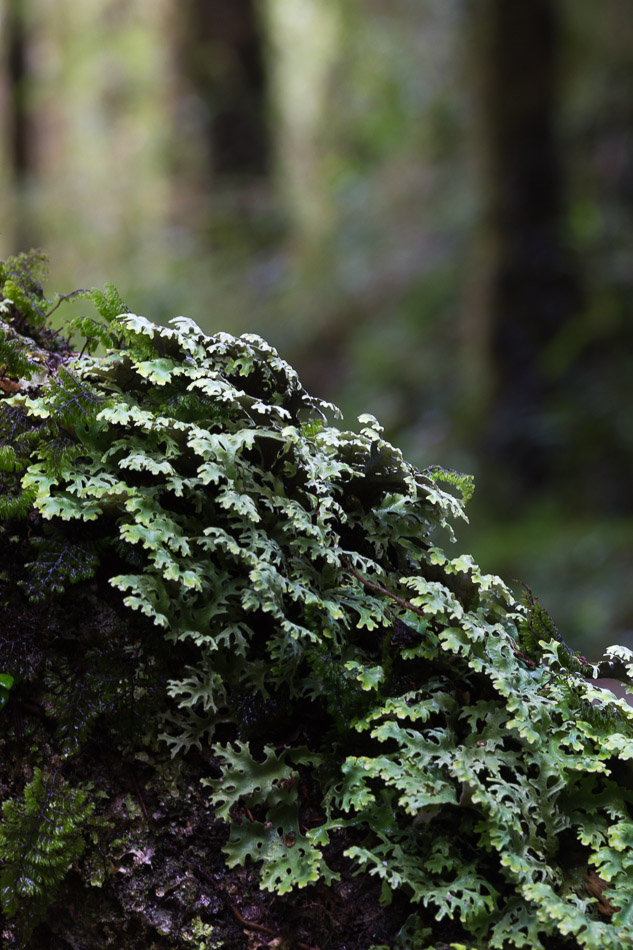
Mosses of every size and shape cover, trees, rocks and paths.
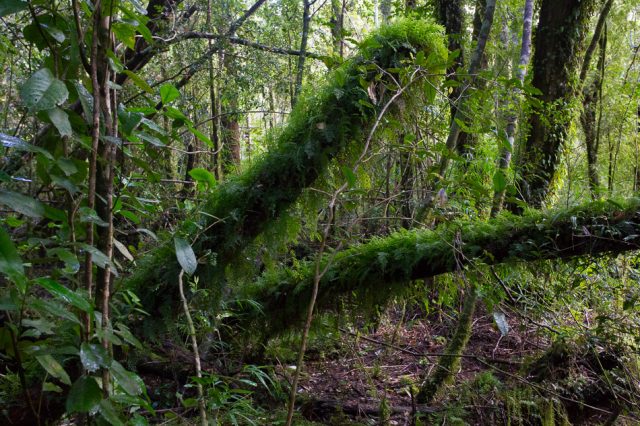
Getting around and through a rain forest is always difficult. Fallen trees, slippery tracks and a profusion of plants wrapping round each other always make progress hard.
Many of the trees of this lovely forest, grow nowhere else. For example in the Valdivian rain forest there is one particular tree, the Tepu, (Tepualia stipularis). It is evergreeen and a member of the myrtle family.
The Tepu tree grows in the wettest of places, hollows left by ancient glaciers. It is a thin and tall tree, but grows densely.
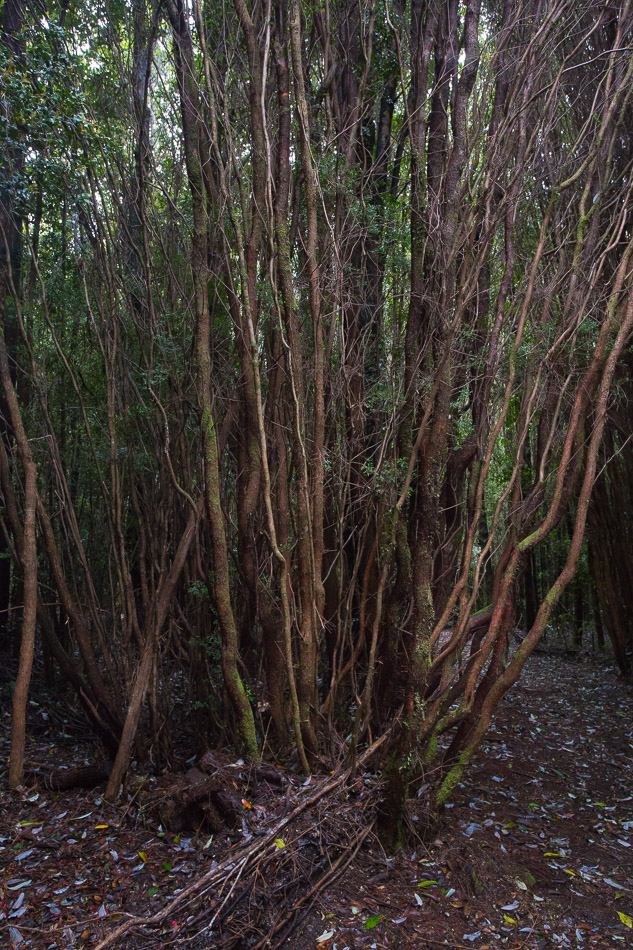
After about after about one hundred years the trees die off quickly and strong winter winds cause them to easily fall onto the forest floor.
Here they pile up and in places raise up the forest floor up to a meter.
This provides a special habitat. Older, much slower growing tree saplings beneath, sheltered from the harsh conditions and grazing deer, whilst the thin soils are protected from the heavy rain.
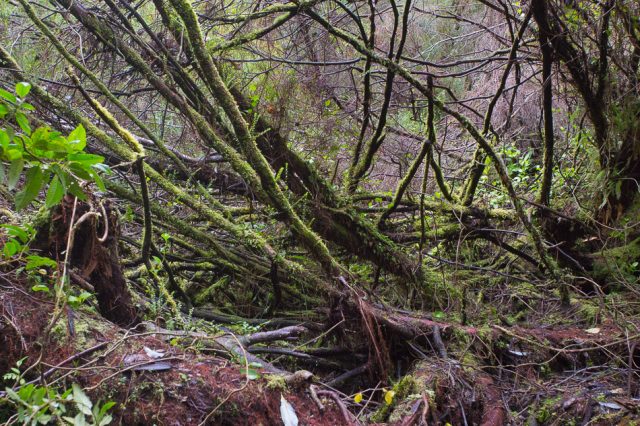
As this artificial layer builds up humus, other shorter lived plants can survive on the top where there is ample drainage and a little more light.
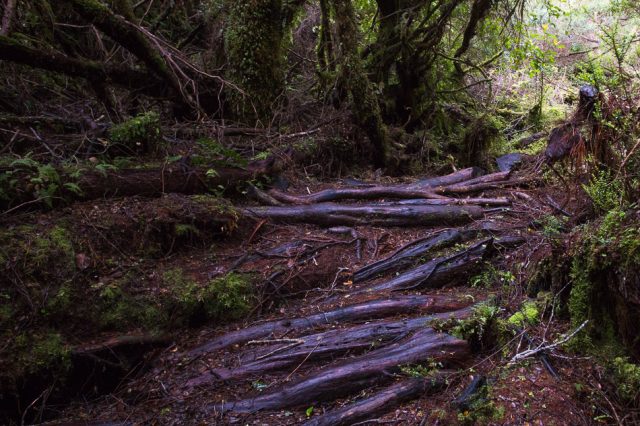
Over the years the forest floor is covered with fallen trunks and as Tepu wood is water resistant they take generations to rot away.
Borders are created by man, not animals.
Borders are artificial, they get in the way of people working together.
Borders are created by man, not animals.
Global environmental problems need people of all nations working together. One solution to this has been the development of ‘Peace Parks’.
What are Peace Parks ?
They are usually National Parks that cross international boundaries.
Often they are called ‘Trans-boundary’ parks.
What is the advantage of a Peace Park ?
Migrating animals can cross between the two nations without hinderance from fences and barriers
The two parks follow and promote a common conservation plan.
Indigenous peoples can move freely over the border.
Examples from Europe.
An EU programme called Natura 2000 has helped creat an impressive network of European wildlife reserves amounting to protection of 18% of Europes land area.
A few of these are Peace Parks.

The image above is of Oulanka National Park in Finland. This park joins with the Paanajärvi National Park in Russia, protecting not only rare mammals such as the Lynx and Wolverine but the nomadic Sami people.
Between Poland and Belarus stretches the last primeval forest in Europe. A peace Park exist between the two countries. In Poland the Bialowieza National Park and in Belarus the Belovezhskaya National park.

Africa has some fine examples.
The world renown Kruger National Park stretches between Mozambique, South Africa and Zimbabwe.
In 2003 a trans-boundary park between South Africa and Namibia was successfully negotiated.
This co-operation led to the creation of the !Ai-!Ais/Richtersveld Transfrontier Conservation Park.
This has protected the cultural heritage of the Nama people as well as securing the conservation of the endemic Succulent Karoo biome.

Nelson Mandela said of Peace Parks
” No political movement, philosophy or ideology does not agree with Peace Parks. It can be embraced by all. Peace is a cornerstone of the future and Peace Parks are a building block in this process”
South America
South America is unique. Of all the worlds continents, nowhere is their a greater plant and animal diversity.
The Cordillera del Condor is a trans-boundary protected area on the border of Ecuador and Peru.
In Patagonia something special has happened recently.
The Patagonia National Park is now a reality. Argentina formalized it in 2017, Chile in 2018
This national park exits on two sides of the border between Argentina and Chile. It is not joined up yet, as there is much private land in between. But the two parks are close together and the potential exists.

Patagonia has an ‘aura’ that attracts visitors from all over the world.
People that seek wilderness. People that want to see the very best landscapes and wildlife that exists on earth.
Patagonia has all that.
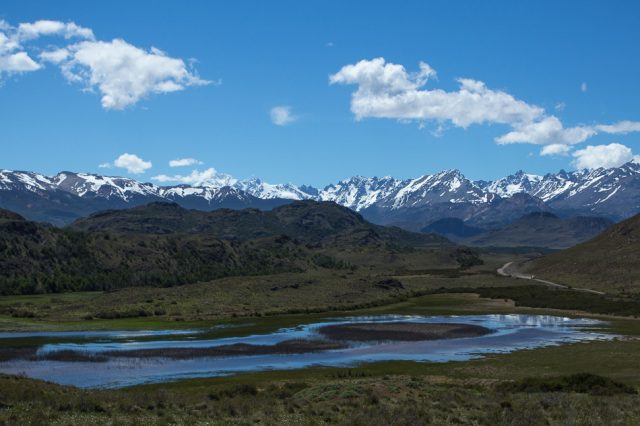
One day hopefullt there will be a trans-boundary Patagonia National Park.
A place where the Puma can thrive, where herds of Guanaco can travel unmolested across the land.
After all borders are created by man, not animals.
A beauty and a beast of a road refers to the Carretera Austral. The longest road in the longest country in the world, Chile.
Travelling south into Patagonia is not easy and staying in Chile will require use of the Carretera Austral.
The Carretera Austral meanders 1,250 km through rugged and remote terrain. It stretches from Puerto Montt in the north down to Lago O’Higgins in the south
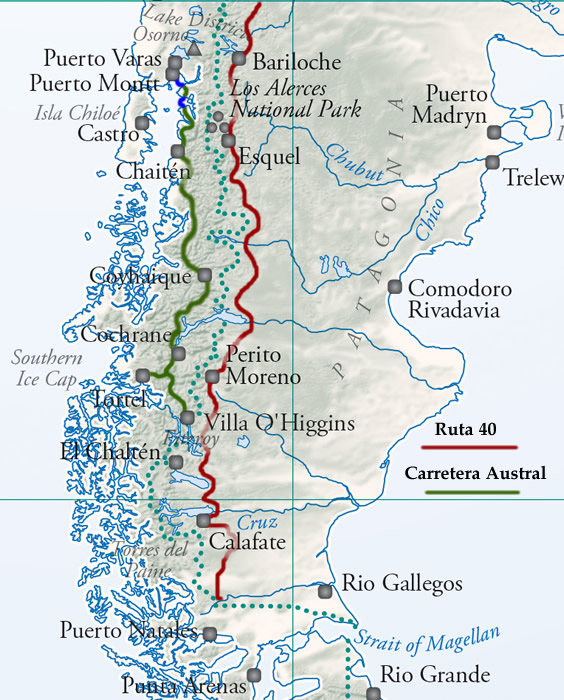
The Carretera Austral is a beauty and a beast of a road.
This is part 2. A blog to highlight and illustrate some of the beastly difficulties we encountered on our journey.
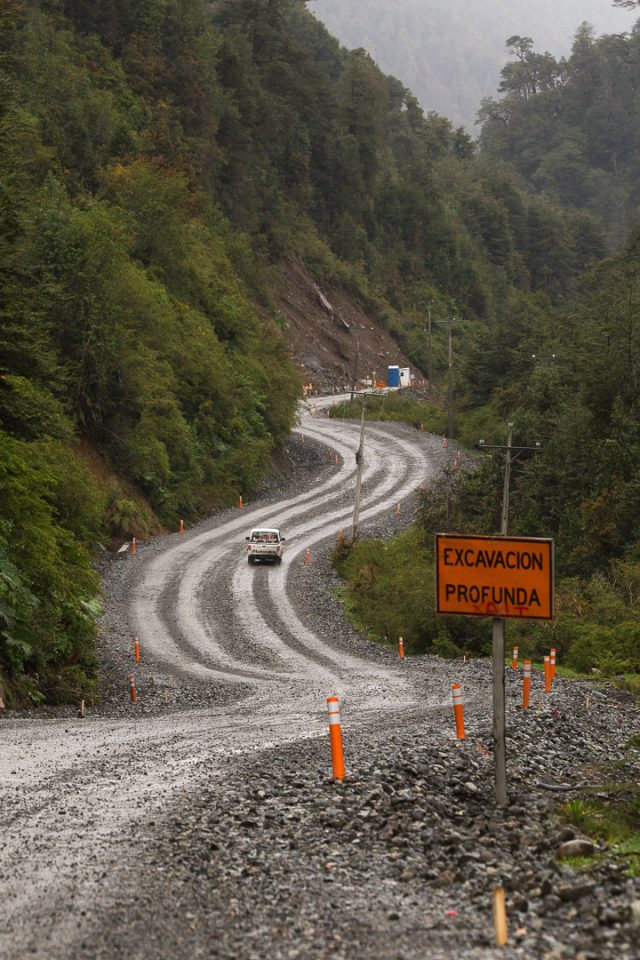
Much of the road is in a poor state of repair. Small sections are terrible.
Always carry spare tyres and a puncture repair kit. There are few places to have such work done.
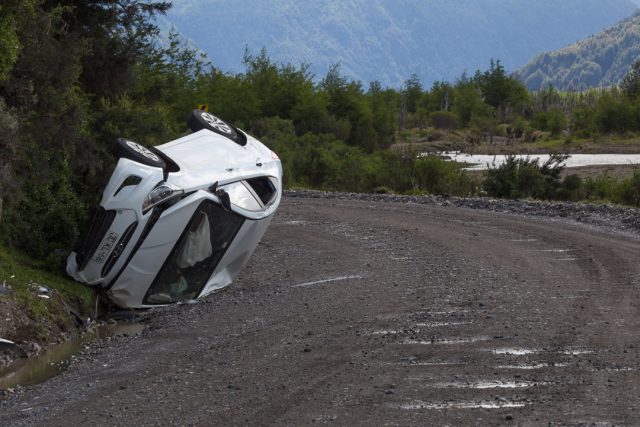
Try to ensure you have a good first aid kit. Medical facilities are few and far between. Drive with care.
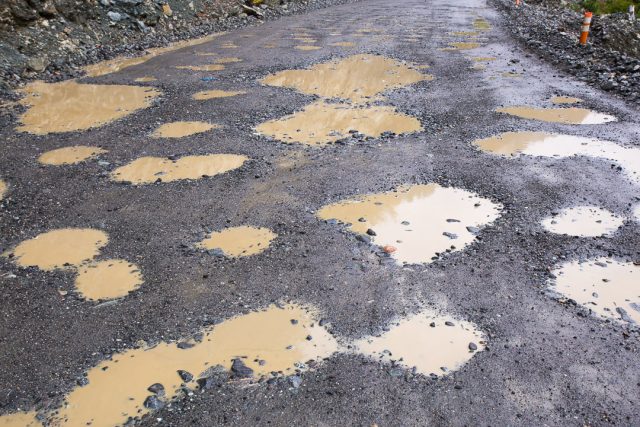
If possible go in a 4-wheel drive. Its not an absolute requirement, but will make life so much more comfortable and safer.

Be prepared for the completely unexpected. Anything can happen.
We met an area where the road had been completely swept into a lake by a landslide.
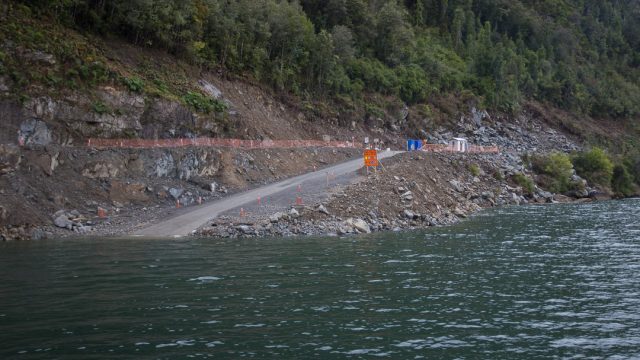
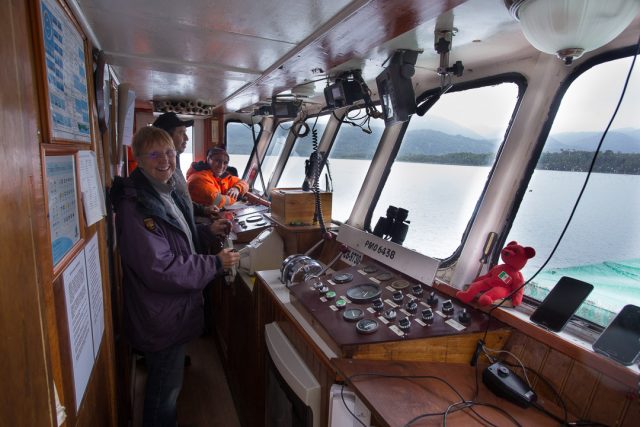
All of a sudden we were directed onto a free ferry service. A voyage that lasted an hour.
Though Paula never expected to steer the boat !
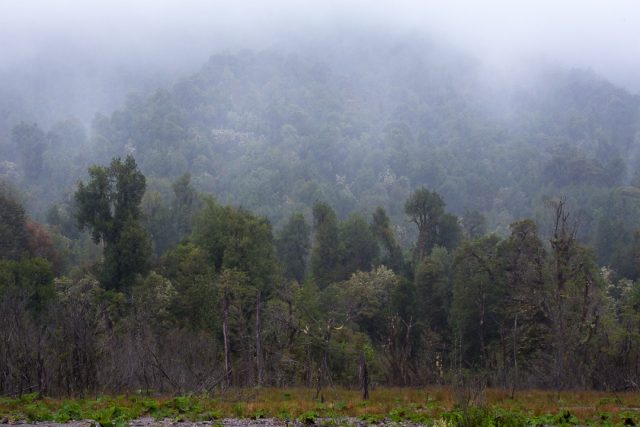
Much of the Carretera Austral passes through forest. Thick temperate rain forest, more akin to British Columbia than people’s expectations of sunny Chile.
The prevailing weather is rain, more rain and sometimes a lot more rain, be prepared.
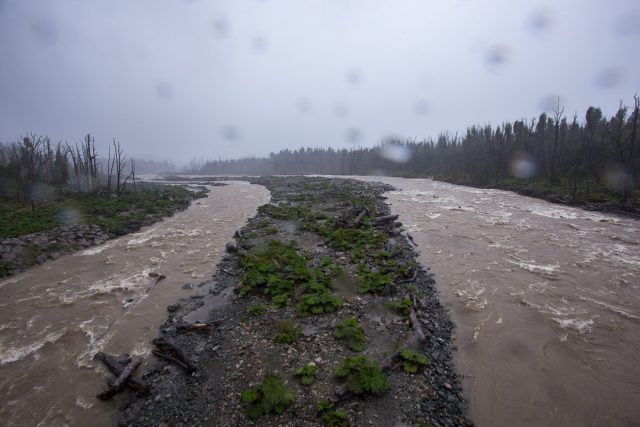
Bridges and roads can be swept away. We are British so we are used to rain, but not like the rain we experienced !
Chilean Patagonia is a land of rain, up to 4 metres a year.
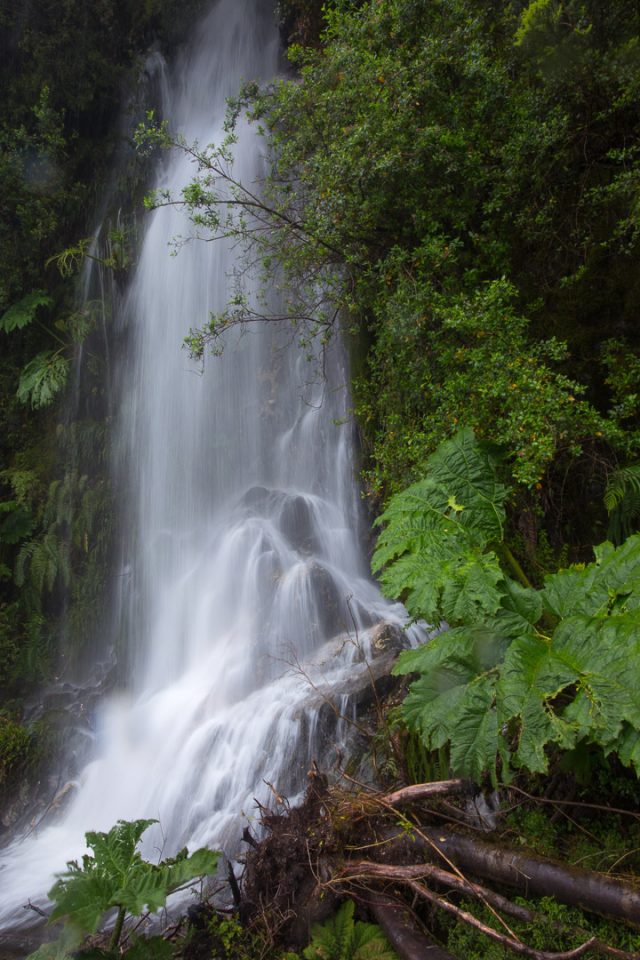
On the other hand we are photographers so rain, sometimes, is beautiful.
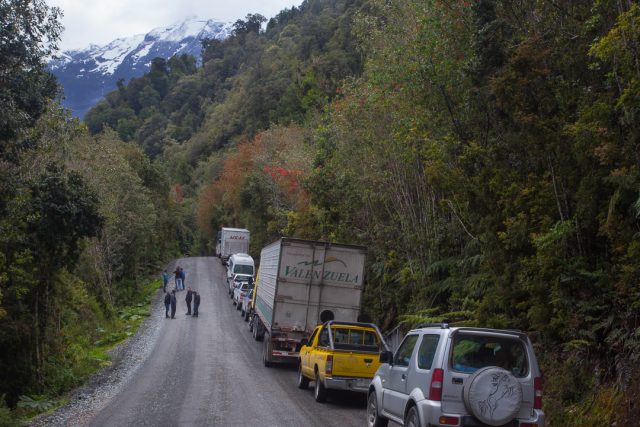
The Carretera is not busy as such, but it is the ONLY route south.
Allow plenty of time to catch ferries and be prepared to wait.
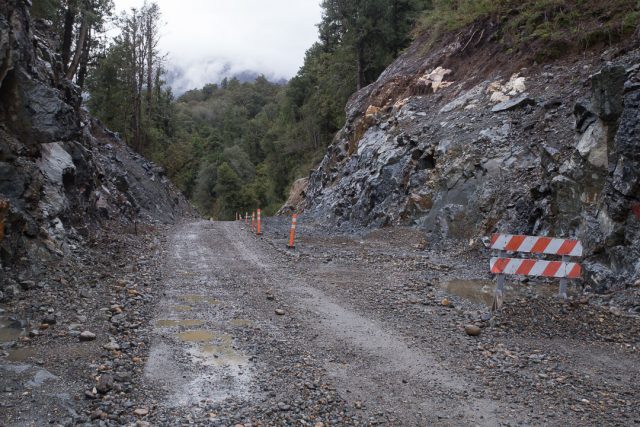
Roadworks are common. Improving the road can involve dynamiting the rock away.
In some situations you can wait an hour or so before they clear the way through.
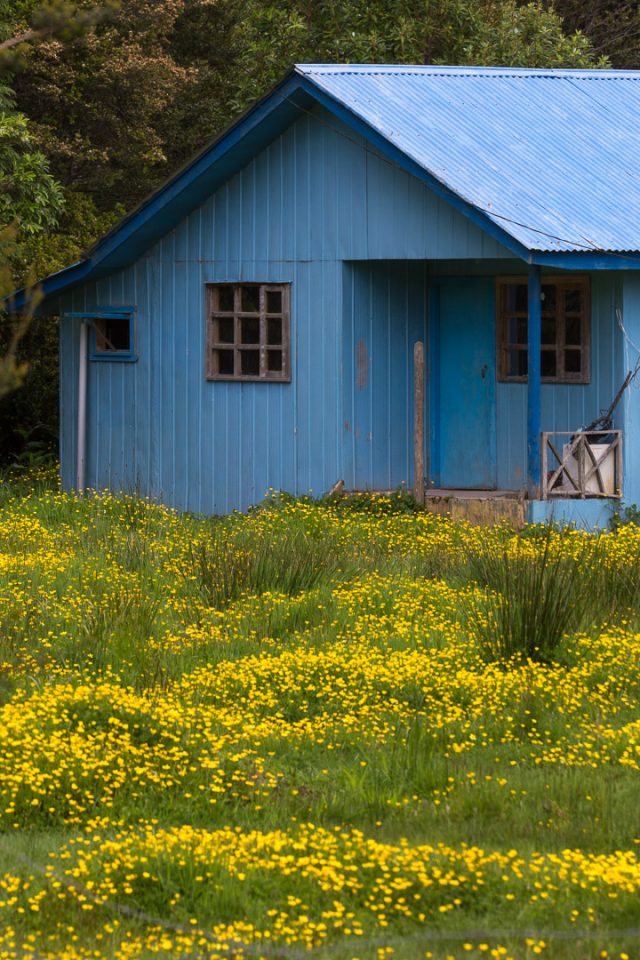
In conclusion, the Carretera Austral is wonderful.
Enjoy the little things, relax and talk to everyone you meet.
The Carretera Austral attracts the most interesting people.
A beauty and a beast of a road refers to the Carretera Austral. The longest road in the longest country in the world, Chile.
Travelling south into Patagonia is not easy and staying in Chile will require following the Carretera Austral.
The Carretera Austral meanders 1,250 km through rugged and remote terrain. It stretches from Puerto Montt in the north down to Lago O’Higgins in the south.

Paula and I completed this road, late in 2017. It was a beauty and a beast of a road.
Beautiful because of the stunning scenery
and a beast of a road because of its poor state of repair in places.
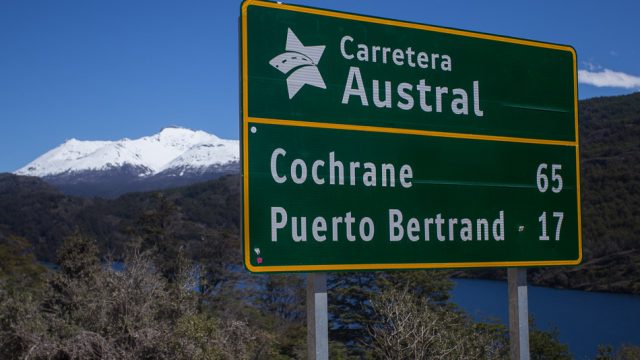
This blog (Part 1) and its photographs highlight the beauty of travelling the Carretera Austral, one of the world’s great driving experiences.
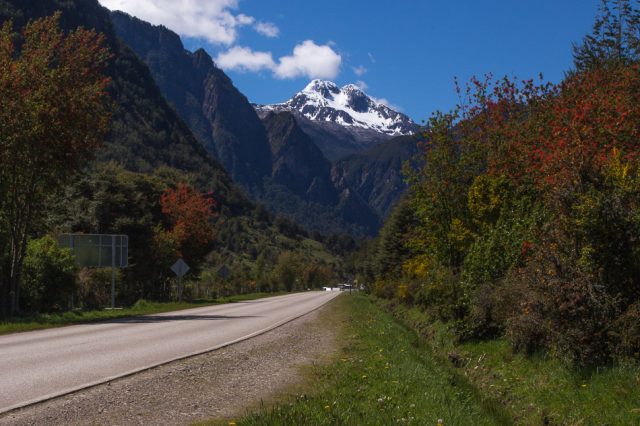
To give a balanced perspective about the Carretera Austral there will be another blog. Part 2 will highlight some of the disadvantages we encountered.
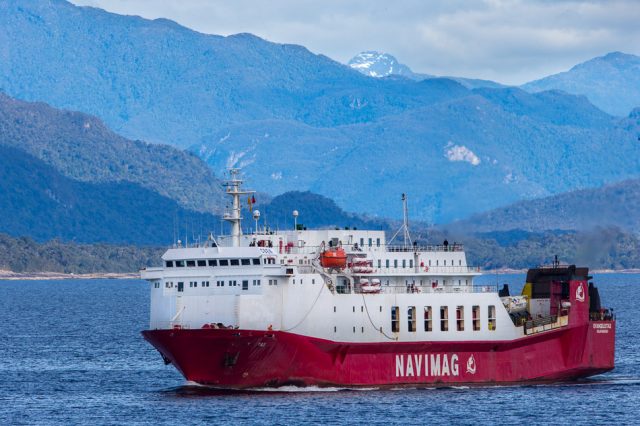
We started off by taking a Navimag ferry, booked in advance in Puerto Montt. It’s well worth using a ferry, there are lots of them. It breaks up the monotony of continuous driving and enabled us to experience aspects of the landscape we wouldn’t have otherwise seen.
Our boat left Puerto Montt and sailed overnight to Puerto Aisen. We were lucky, the weather was good so the sea stayed calm, enabling us to see albatrosses, gulls and petrels.
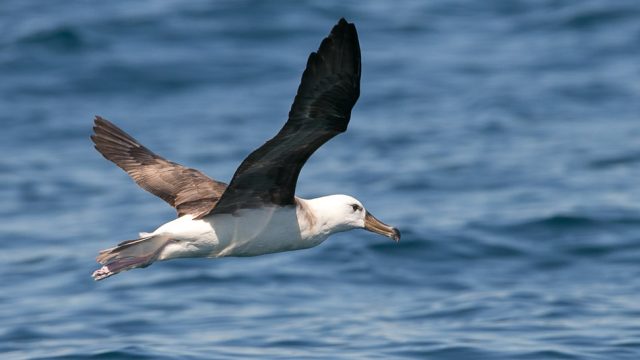
Black-browed Albatross
The ship travels through wide fjord like channels. The passage between the mainland and Chiloe island protects the ship from the roughness of the Pacific sea. The land either side being swathed in dense temperate rain forest, a memorable voyage.
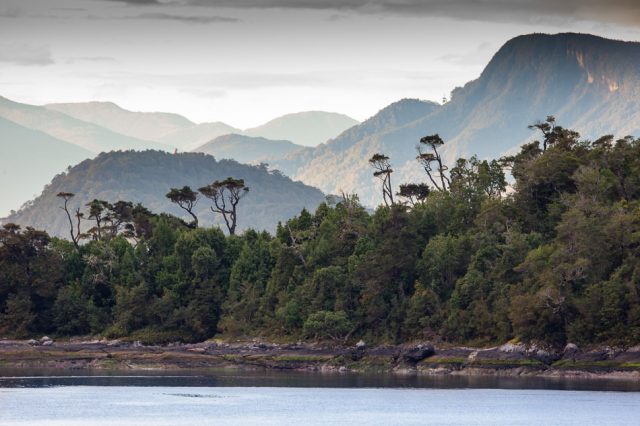
There are a few places to stay in pretty Puerto Aisen or you can drive to the much larger Coihaique. We preferred Puerto Aisen!
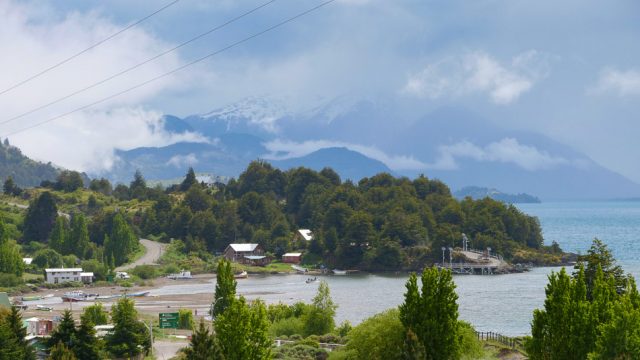
Further south lies Puerto Tranquilo, a quaint village bustling with tourists. We found it a great place for accommodation, food and things to do. More importantly, it’s one of the few places on the route to get punctures repaired.

After Puerto Tranquilo the scenery becomes spectacular. The road skirts the azure coloured , glaciar fed Lake Tranquilo , overlooked by the distant snow capped Andes.
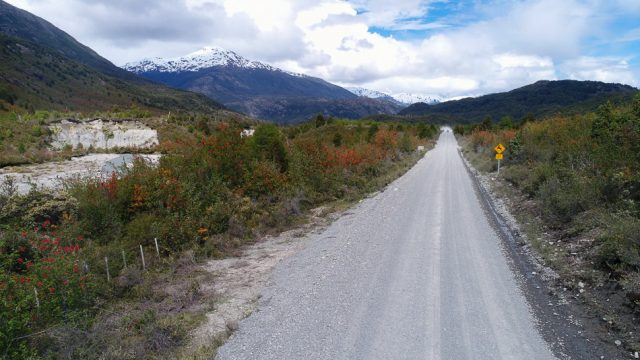
Most of the Carretera Austral is stone and gravel (ripio). However every year sees more and more improvements.
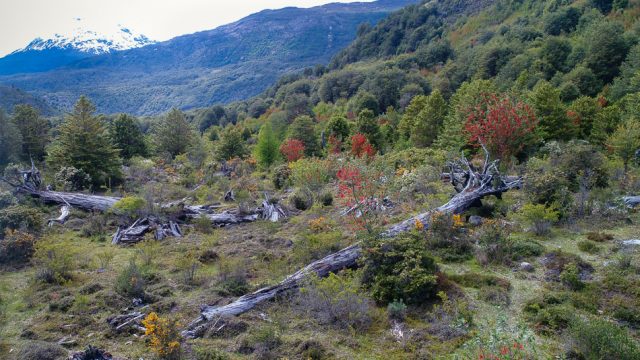
When the ripio is in good repair it’s fine, but it did cut down our speed. Not a problem to us as we are bird watching as we go and the surrounding countryside is full of colour and interest.
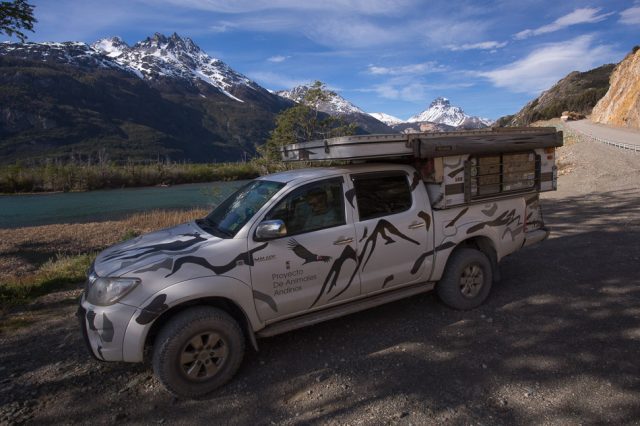
We drive our own vehicle and camp wherever we can. New stretches of road often leave older sections in disuse where it is easy to camp.
A memorable day for Paula and I was the discovery of a Painted Snipe chick accompanied by its parent.
We were sploshing about in a marsh, in central Argentina.
Mud was up to our knees and we were trying not to fall over in the stinking morass.
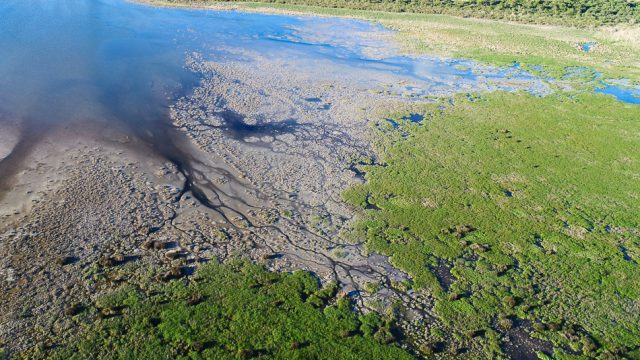
Marshes are wonderful places for animals to live because they are ‘on the edge’.
In between land and water, not the greenery of vegetation nor the cool trickling of liquid.
The quaggy, boggy, gooey stuff that can be both dangerous and exhilarating.
Birds that live here have the best of both worlds.
They can find ample food on the sparse vegetation and underneath the wet mud.
To survive in such a place a bird needs to be a specialist and the Painted Snipe is just that. The birds have long legs with splayed out toes, ideal for crossing the mud and sensitive bills to probe for food.
Cover, in the way of protection, is limited on a marsh. Keeping safe means keeping hidden and the Painted Snipe chick and its parent do this so brilliantly, they are seldom seen.
Many birdwatchers go their whole lifetime without seeing a South American Painted Snipe.
Paula and I were loath to go into this particular marsh. Marshes are not places for the faint-hearted. But we heard and saw lots of birds flying overhead, so into the marsh we went, treading carefully and quietly.
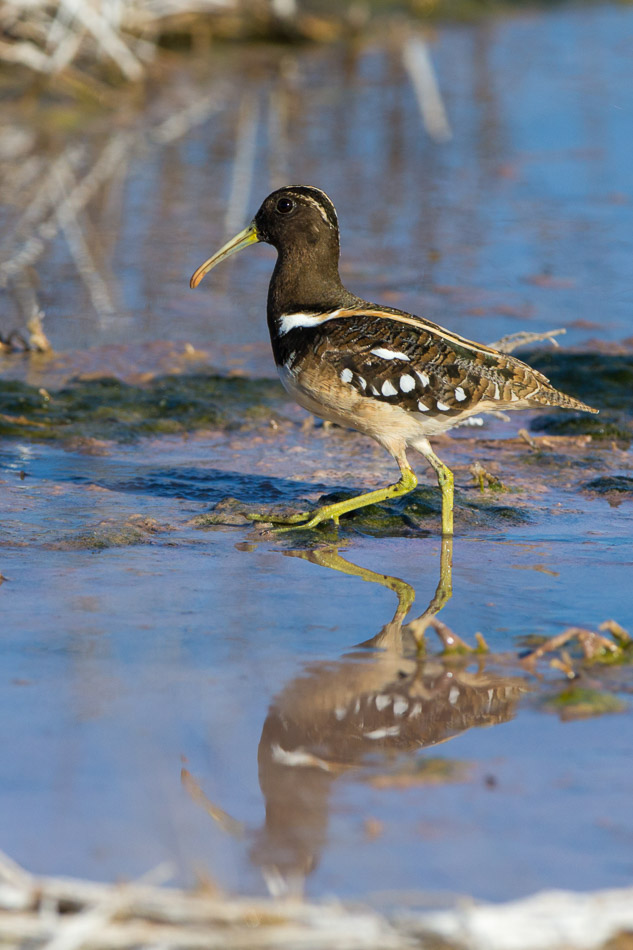
To our surprise and delight we came across an adult Painted Snipe. Its gorgeous cryptic patterns reflecting its surroundings.
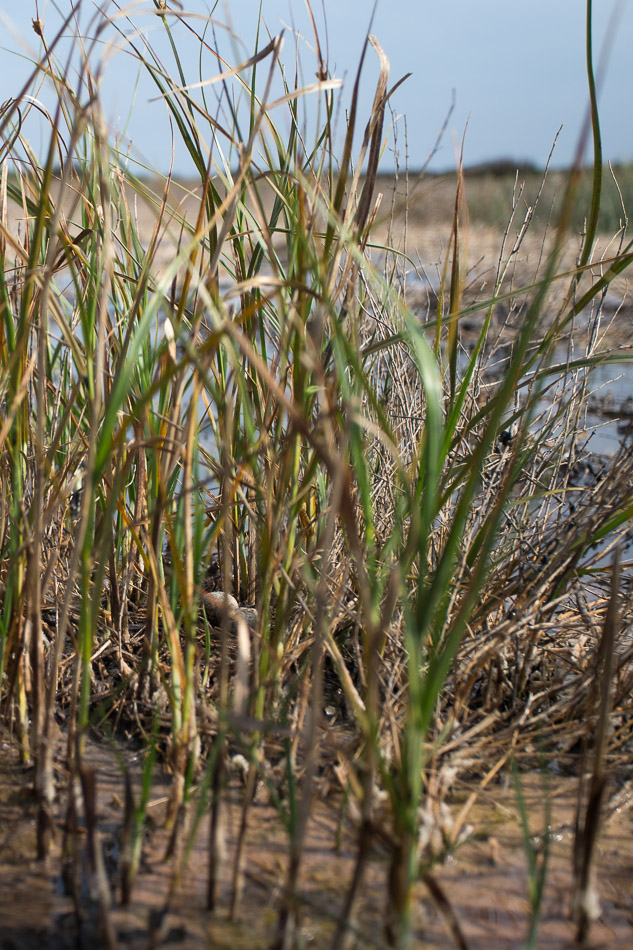
We searched carefully, eventually finding what we were looking for – the nest of the Painted Snipe, with two eggs.
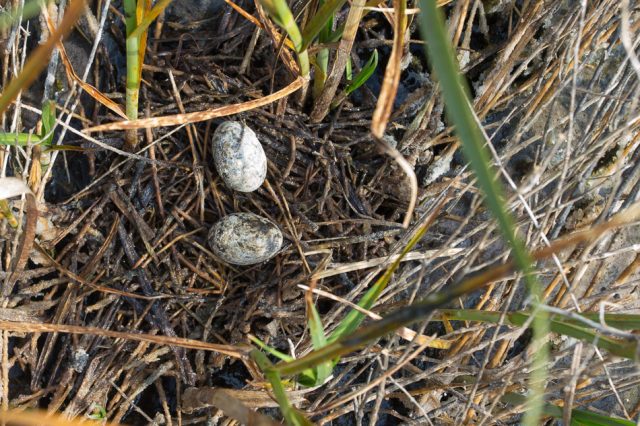
We retreated, so as not to disturb the bird.
A week later, with wellingtons on and a stick to feel the depth of the mud as we walked, we staggered back into the swamp.
The nest was empty, so we searched and searched.
We were lucky. This was the day we made the Discovery of a Painted Snipe chick and even better, with its parent.
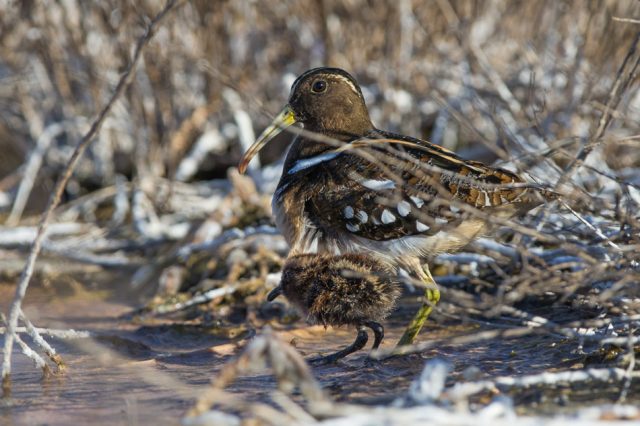
The adult remained motionless, as if stuck in the mud.
But the little chick manoeuvred itself close to its dad and snuggled underneath the bird .

All you could see were its legs poking out from beneath the belly of its parent. The chick comfortable in the belief that if it couldn’t see us then we couldn’t see it !
We left the Painted Snipe and its chick in peace. Happy to have seen this reclusive wading bird so closely and to have watched a comical bit of bird behaviour.
Imagine a turquoise river, a river as blue as a Pacific lagoon.
The same river, as cobalt blue as the Atlantic, whose waters turn pink at sunset.
With ripples of crimson pointing the way for geese.
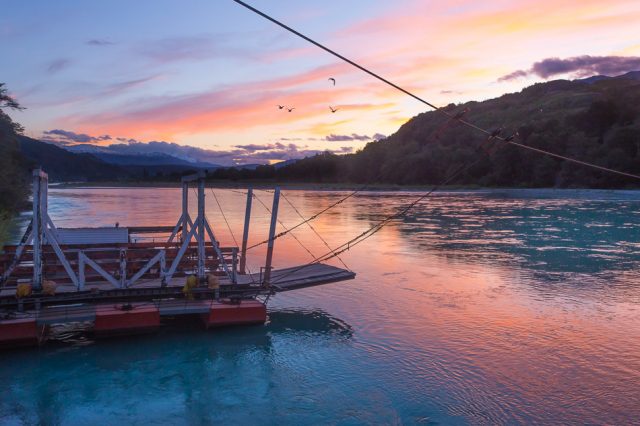
Imagine a turquoise river, waters fed by a distant glacier.
A sinuous, sapphire scarf wrapping round sandy banks.
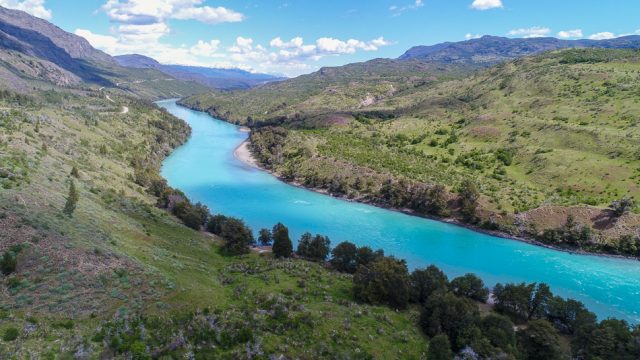
Imagine a river whose eddies, gurgles and foaming fury carry kayaks onward to an exhilarating ‘rush’.
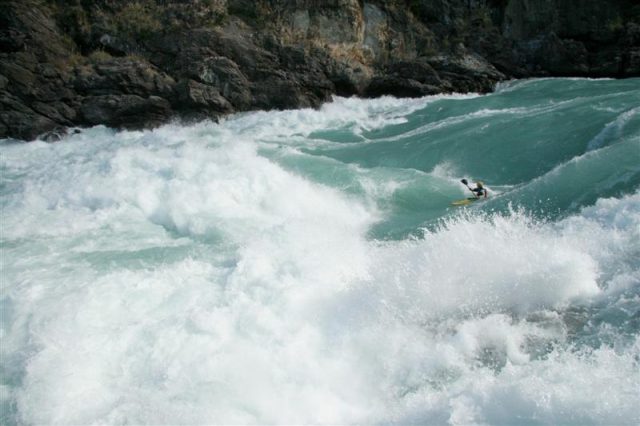
Its difficult to imagine that river tamed. Stilled, quiet and sullen.
That’s what might have happened. 5 mega-dams planned across the Baker river, a wild river gone forever.
Dam the Baker river, dam Patagonia was the cry.
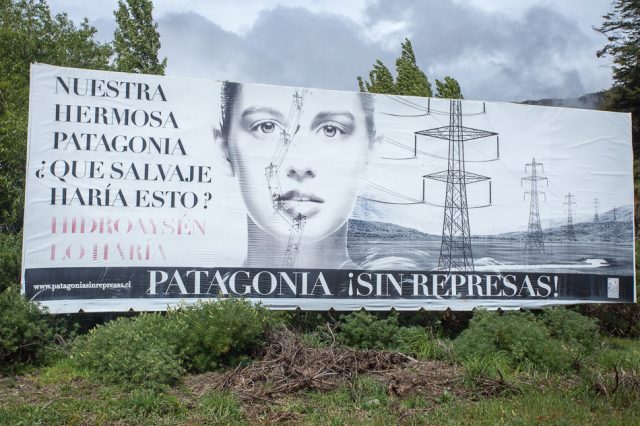
Every river has its beauty, but the Baker is more than a river, it’s a magic Magellanic world.
Feeding forests as old as time, Alerce, Coihue and Lenga.
A pristine pearl, born from and protected by, snow capped mountains.
Stop imagining a turquoise river, it’s there and always will be. Waiting for you to go, in Patagonian Chile.
